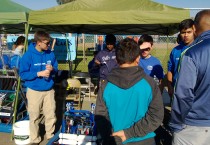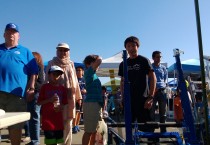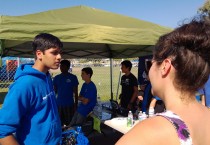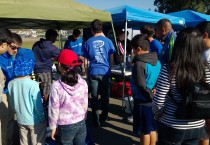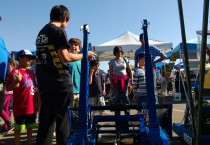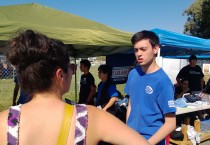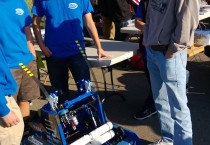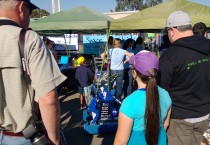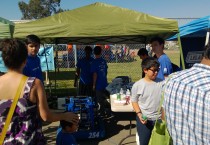Blog
Day 12.5 – Testing the Lidar
Today, the team tested an advanced Lidar Sensor solution. Extensive testing was performed (approx 30 min).
Day 12: Design Review and Further Prototyping
by Dan Ngo ’17
Design Review
The highlight of the day was the design review, during which the team congregated to discuss and possibly finalize the strategy and conceptual robot design thus far. The team decided that its overall strategy would be aimed at being able to first self score all three balls in autonomous. This removes any risk of relying on teammates during this valuable portion of the match. Subsequently, in teleoperated mode, general scoring would be prioritized. Assisting, while useful for qualification points, will likely only become significant in elimination matches.
Regardless of strategy, we agreed that the robot should be able to perform all the tasks in the game (shooting, passing, catching, etc.). We determined that a flywheel shooter aligns with these goals and packages nicely in the robot’s envelope. Additionally, to be able to score all three balls in autonomous, the team would first need a mechanism to hold and feed them into the shooter. This is currently being prototyped.
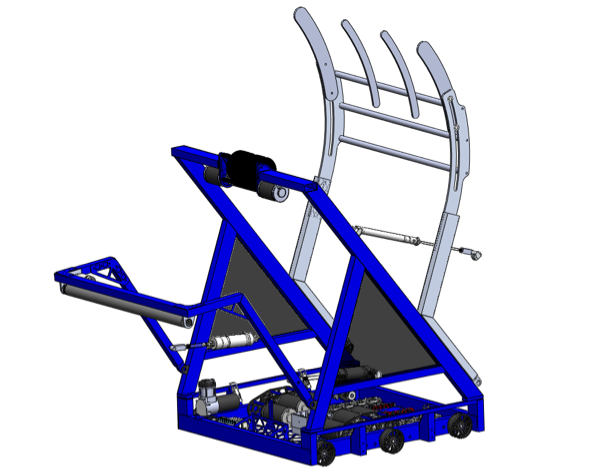
Programming
Team members continued work on integration of the ultrasonic sensor. We also worked on making programs to remotely access feedback from the robot, to ease autonomous testing. We also installed new, smaller, joysticks on the control board. These joysticks use hall effect sensors instead of potentiometers for more reliable and precise control.
Manufacturing
Today, groups worked on machining parts for the gearbox, the ongoing arm prototype, and started the feeding mechanism prototype.
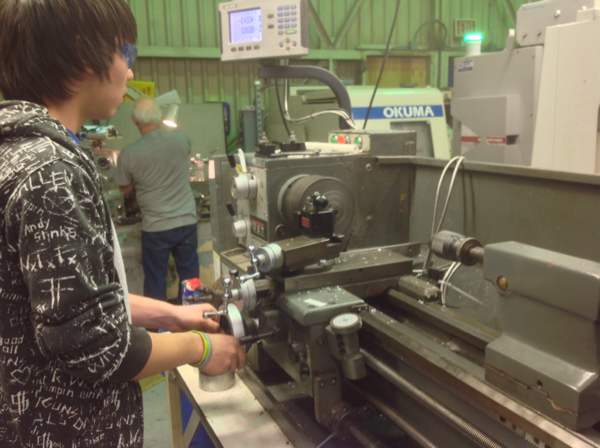
Action Items
- Continue intake prototype
- More testing and coding
- Work on the feeding mechanism prototype
Day 11: Prototyping, Design, CAD, and Testing
by Trevor Salom ’17
Programming
Today, the programmers worked on testing a VEX ultrasonic sensor to see whether the robot could use it to gauge its distance from the wall of the field. The VEX sensor was used as a temporary stand-in while the programming team awaits the arrival of the competition sensors.
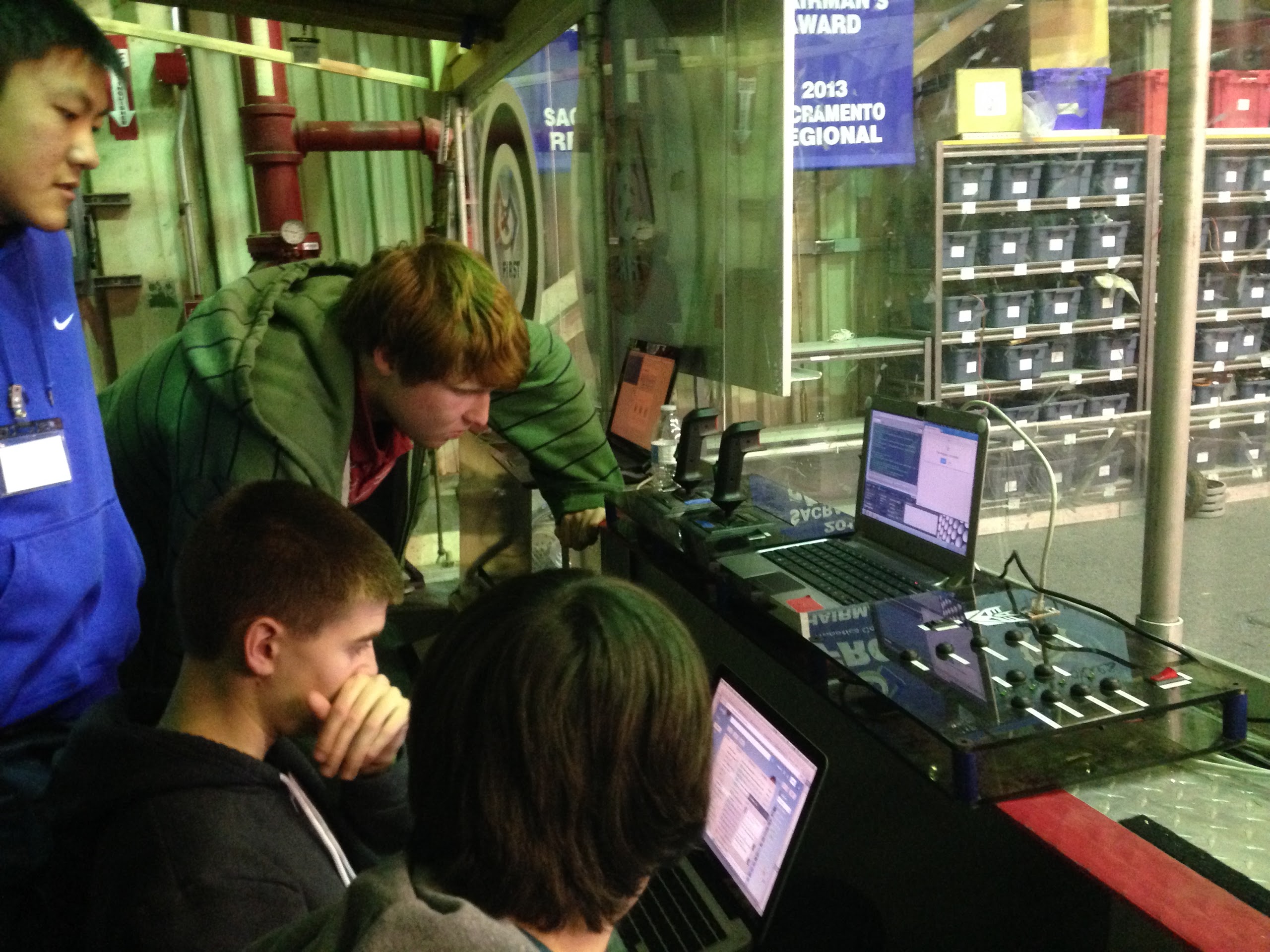
In addition, they continued working on applications to graph the feedback sent by the robot.
Design
Today, we continued the design of the robot and continued detailing the main intake, the shooter wheel and the actuating hood. The shooter is powered by two mini CIM motors with power transmission through small GT2 timing belts. The front intake has a 550 motor mounted on the end of the arm with a two-stage belt reduction aimed to give a roller surface speed around 15 ft/sec. This speed was determined by estimating the average robot speed while intaking (10 ft/s) and determining the amount of time we hope for an intake to take.
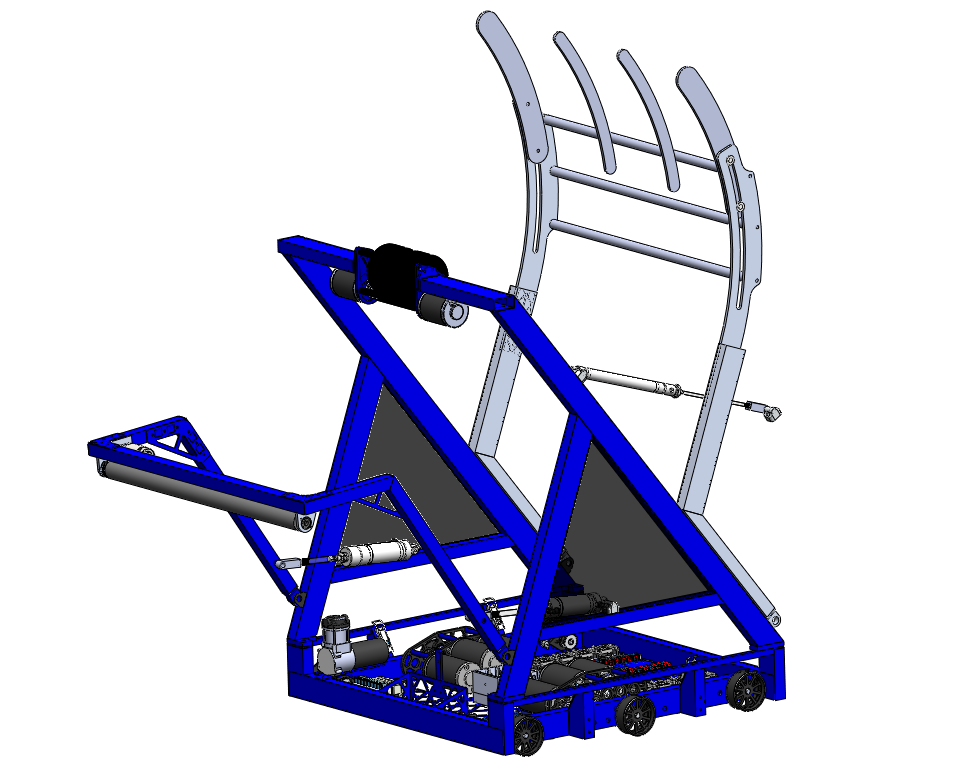
Furthermore, we finalized the design of the baseplate and continued work on the design of a drill holder.
Manufacturing
Today, we began making the outer bearing housings. A large order of material arrived today from our aluminum supplier. The aluminum plate for the robot bellypan was dropped off at sponsor BAE systems for waterjet cutting. We expect the baseplate to be cut on Monday.
Furthermore, a number of team members cut tread today. This tread will be used on practice wheels for existing robots and may eventually be placed on the competition robot (once its wheels are made).
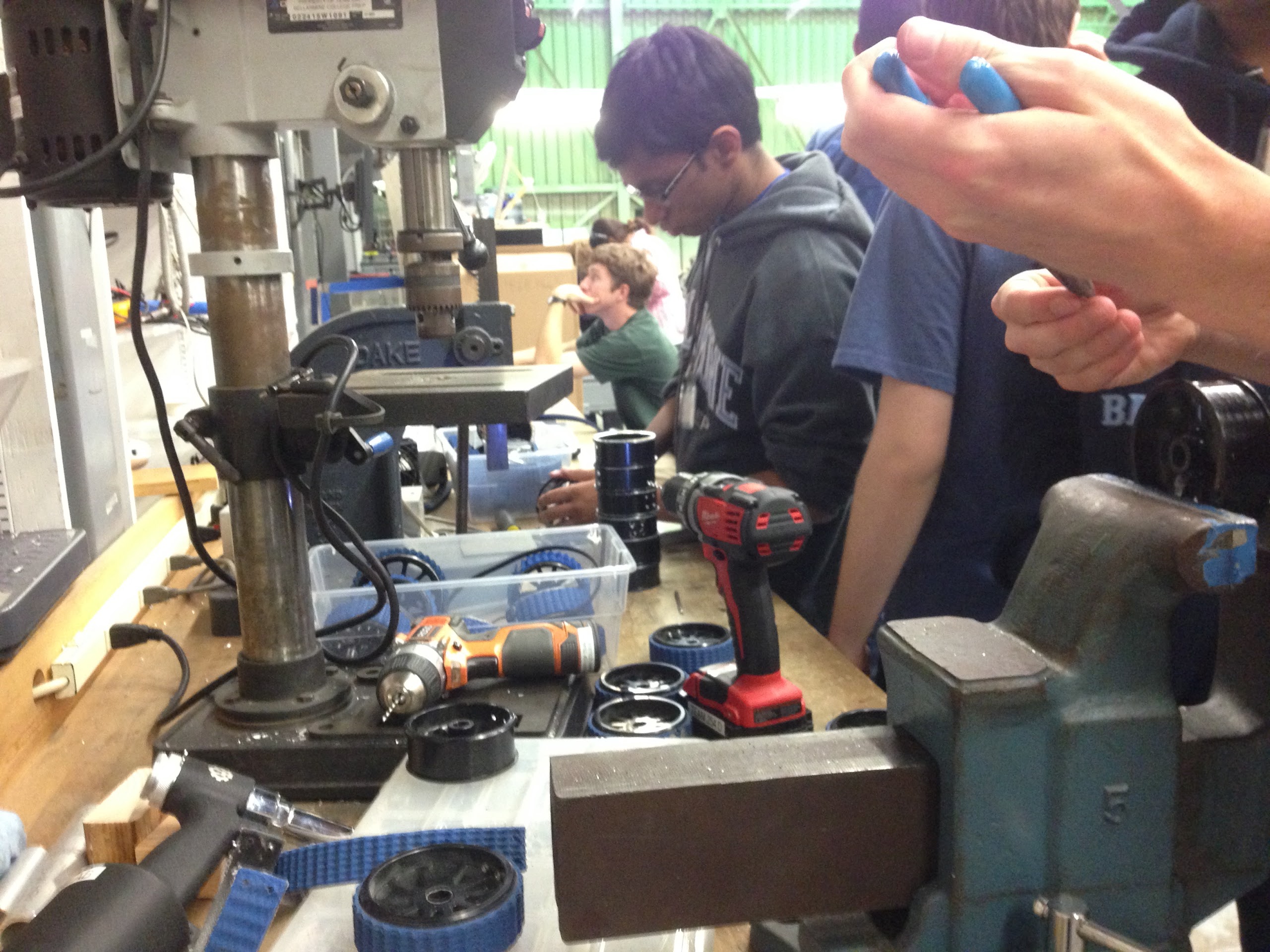
Roller Intake Prototype
Work was also started on building a more refined version of the roller intake prototype. The intake will be raised and lowered by pistons, and will be based on a CAD drawing of the final design.
Action Items
- Finalize Robot Design and CAD under Andrew Torrance and Mani Gnanasivam
- Refine Intake Prototype under Dan Judnick
- Programming and related testing with Brandon or Stephen
- Help out the Media Team under Kevin or Maxwell
- Ask a leader or mentor or request access following the instructions on the whiteboard to see what other tasks are listed on the Trello.
Day 10: Rest Day
In honor of our first day of rest of the season, here’s a GIF of the season’s latest dance craze.
Today, we didn’t meet at the lab. Some team members worked on CAD on their own.
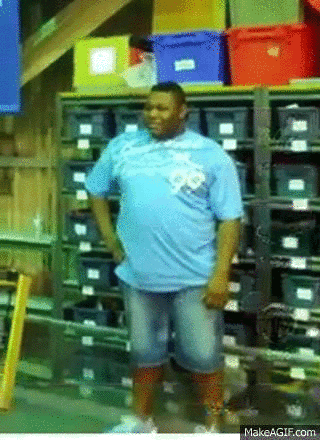
Day 8: Prototyping and Miscellaneous
by Christian and Michael Simeon
Catcher Prototype
Today, students lined the catching prototype with VEX field flooring tiles to help keep balls in the catcher by preventing them from bouncing off the PVC pipes and rope. Students also improved on the attached intake prototype. Additionally, they attached gyroscopes and encoders to allow the prototype to better recognize angles and ultimately better function. Students have begun testing for those encoders and gyroscopes added to the drive base. Sending data from the encoders and gyroscopes to a web browser with graphs and statistics on the robot will help with fine tuning the prototype.
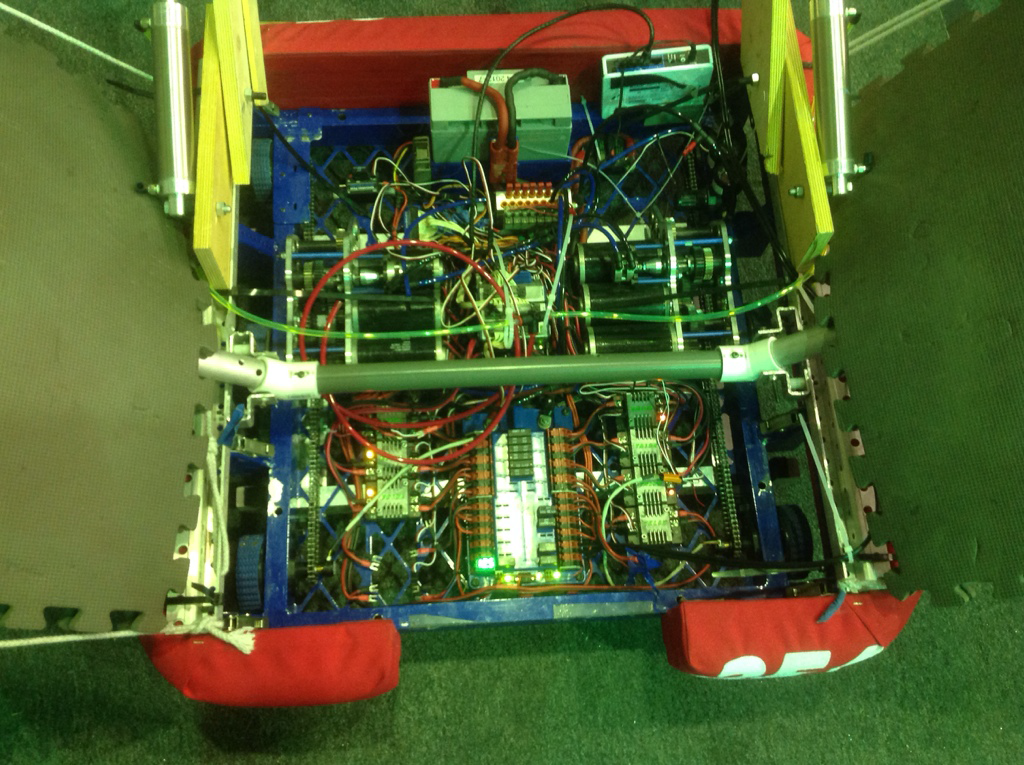
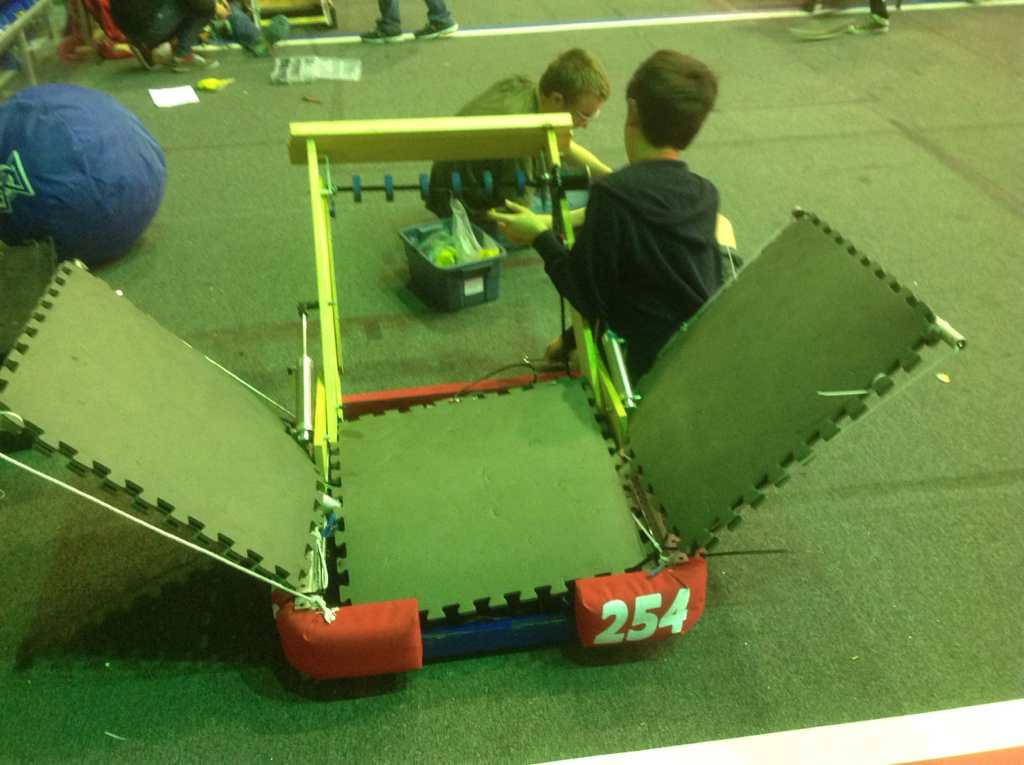
The Shooter Prototype
An elevator system with metal bars and PVC has been added so that balls can be more consistently fed into the shooter. Additionally, the arch on the top of the shooter prototype has been modified. Later, metal and PVC were removed and replaced with a frisbee and cables.
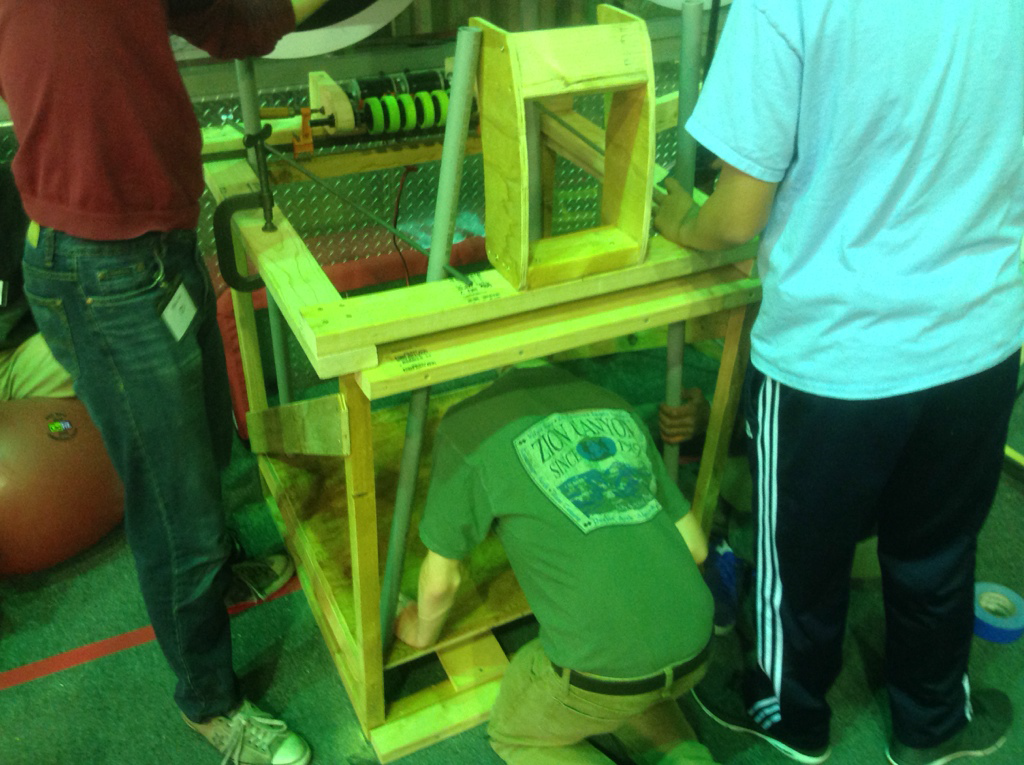
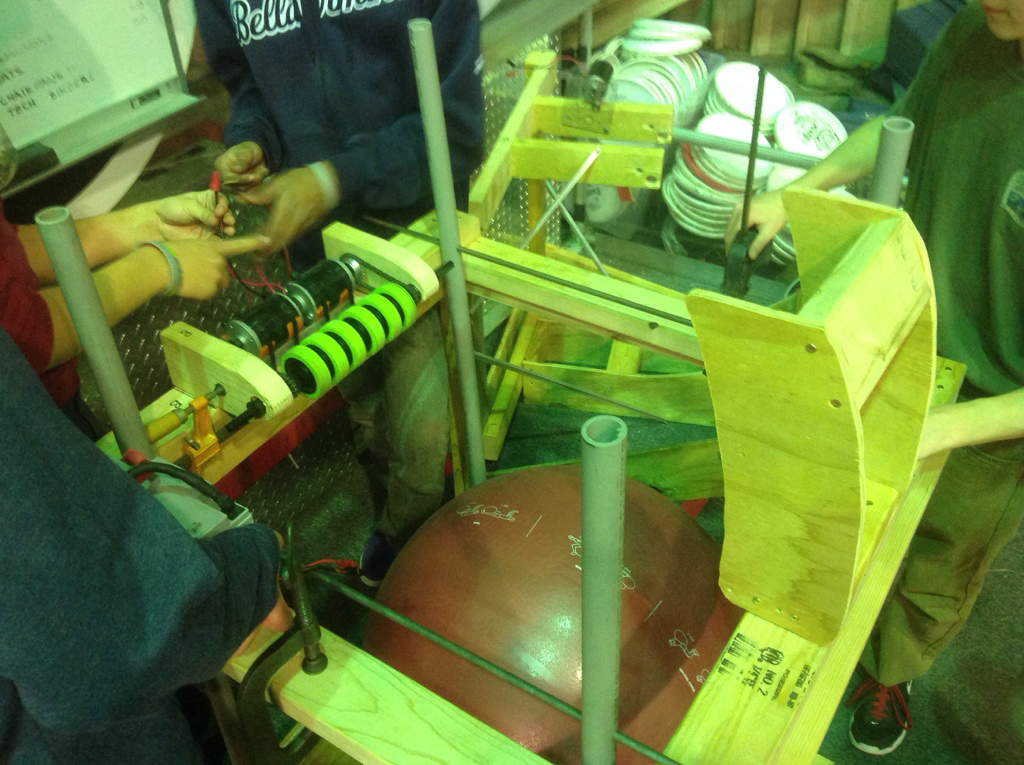
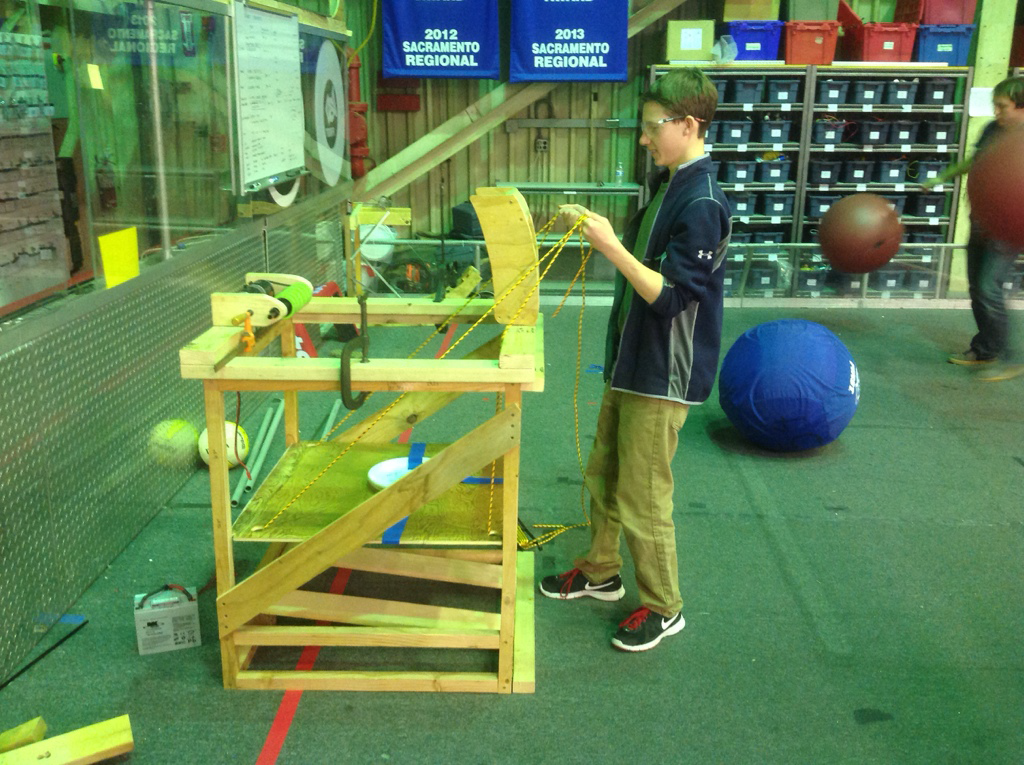
CAD
Today the people working on CAD continued working on drive base. They mirrored the gear box for the other side of the robot and added it to the drive base CAD. They also added the electronics and other necessary components. Finally, they also made part drawings for spacers in the gear box.
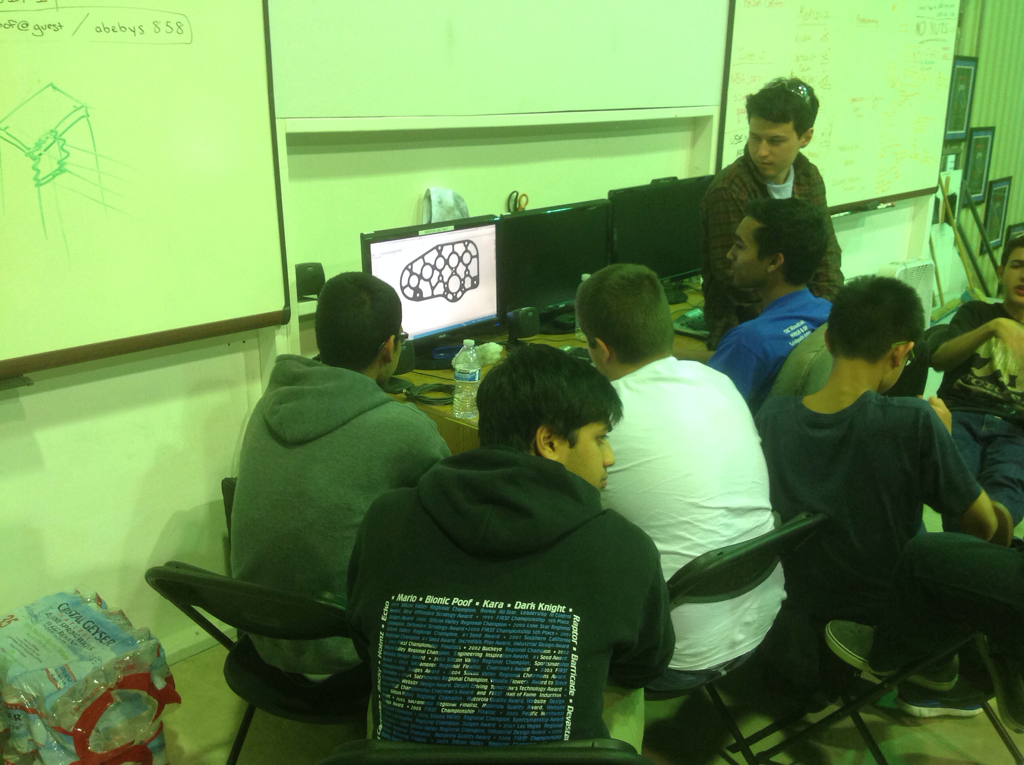
Team members also continued thinking about packaging options for the superstructure. We have decided on having three pivoting arms for the robot’s two intakes and catching hood. All arms will be piston-actuated and are designed to fit within the 20″ extension rule. The intakes are bent to allow for rollers to contact balls as the robot spins to grab a ball. With straight bar intakes, the bars could push balls out of the way of the intakes.
We also discussed mechanisms for locking the hood in place during shots to prevent the balls from pushing against air pressure to reduce hood compression. Discussed mechanisms included an over-center piston linkage and a locking piston mechanism. We will likely move forward with the locking piston mechanism.
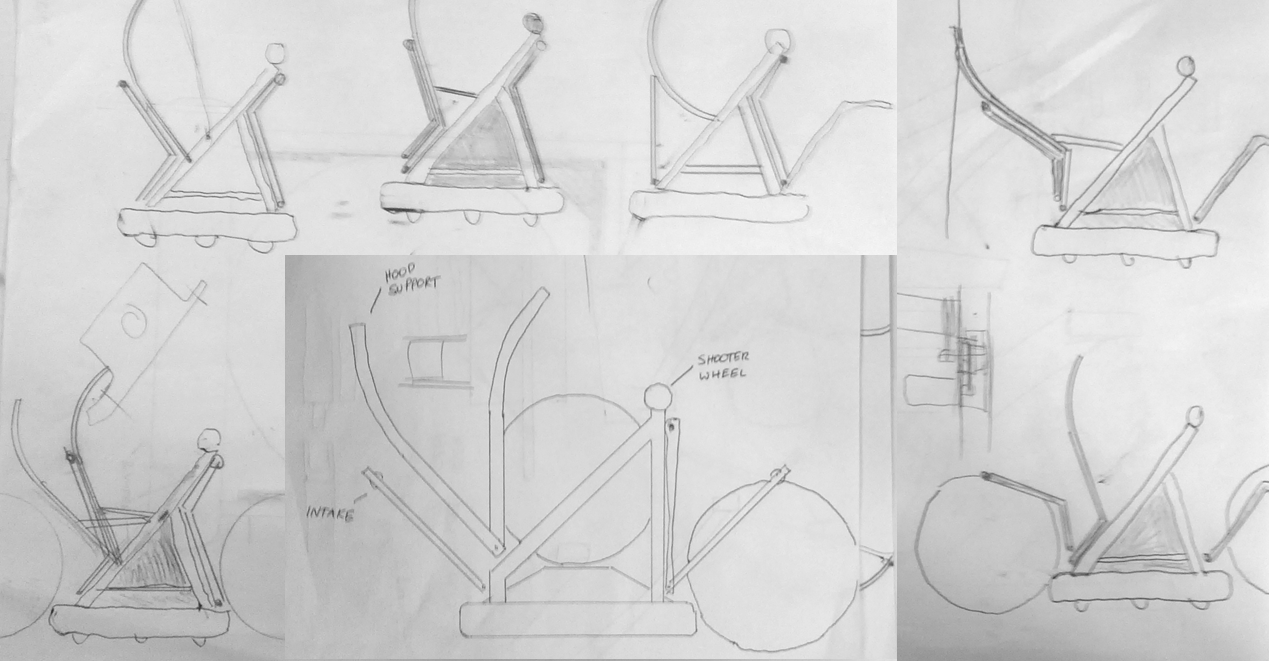
Miscellaneous
Students and mentors worked on the lathe to create standoffs for the gear box. Additionally, work continued on submissions for the Entrepreneurship, Chairman’s, and Media and Technology Innovation Awards.
Action Items
- Finalize entire drive train design and CAD with mentors to prepare for ordering the baseplate
- Finalize catcher prototype with Abhi
- Finalize control board design with Brandon Gonzalez, Chris Sides, and Abhi Kumar
- Work on pit display with Travis
- Brainstorm ideas for publicity releases for team social media sites for releases throughout the build season: for Jeremy, but he will not be there
- Create and maintain a Gantt chart for Mani
- Help Mani clean up
- Ask a leader for other tasks on the Trello
Day 7: Prototyping, CAD, Testing, & Lab Improvements
Catcher & Intake Prototype
Today, several team members integrated the intake and catcher prototypes with the 2013 practice robot drive base to create a prototype robot that can catch and intake the balls. They removed the catcher arms from the back and front of the drive base and placed the intake in the back of the drive base. Additional planks of wood were attached to the walls of the intake to increase the compression on the ball while from the intake.
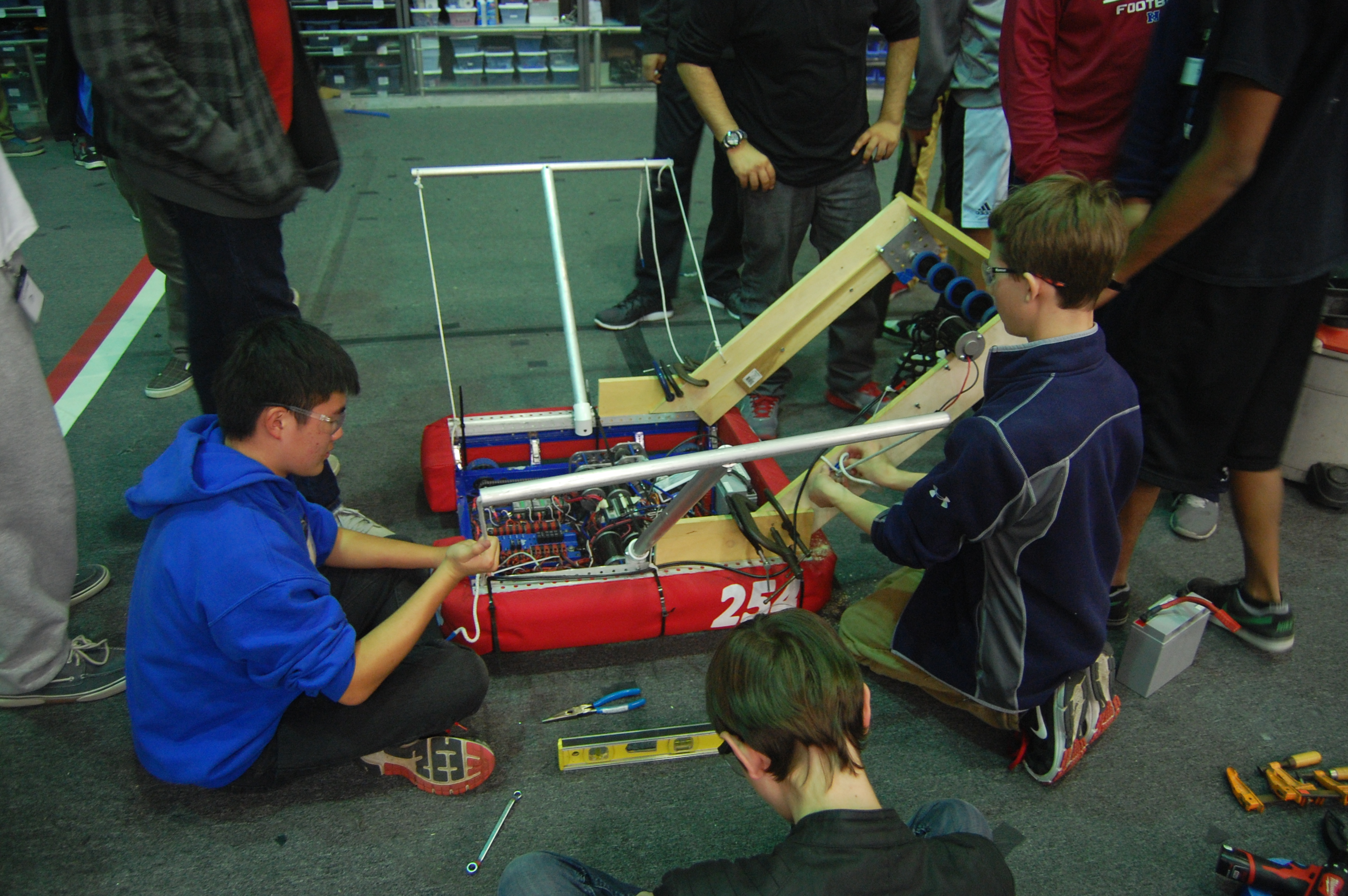
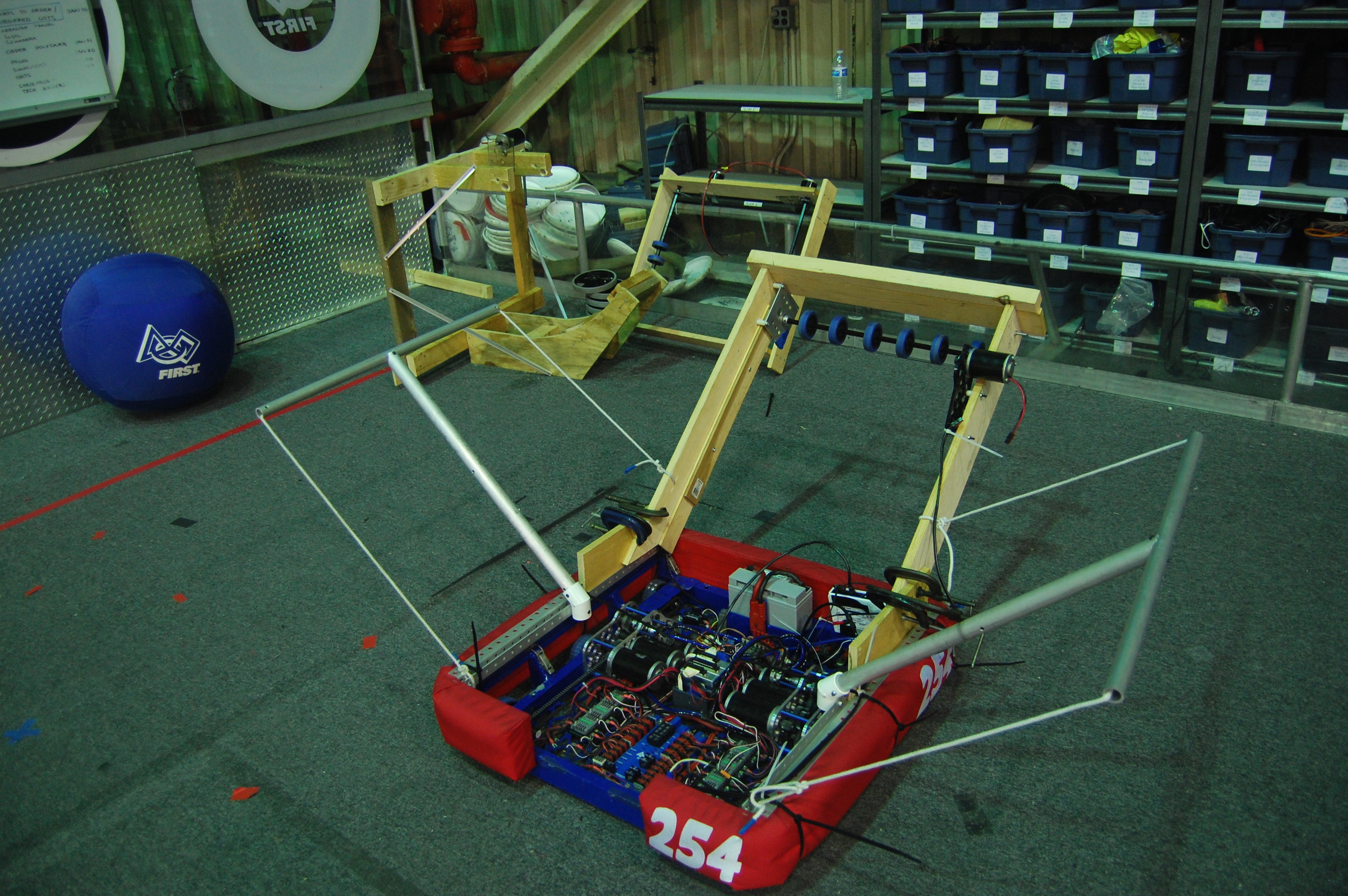
Several students began working on a new intake roller prototype. This new mechanism uses 1.5″ neoprene rubber rollers instead of the current 3.5″ blue bane’s bots wheels that are currently being used.
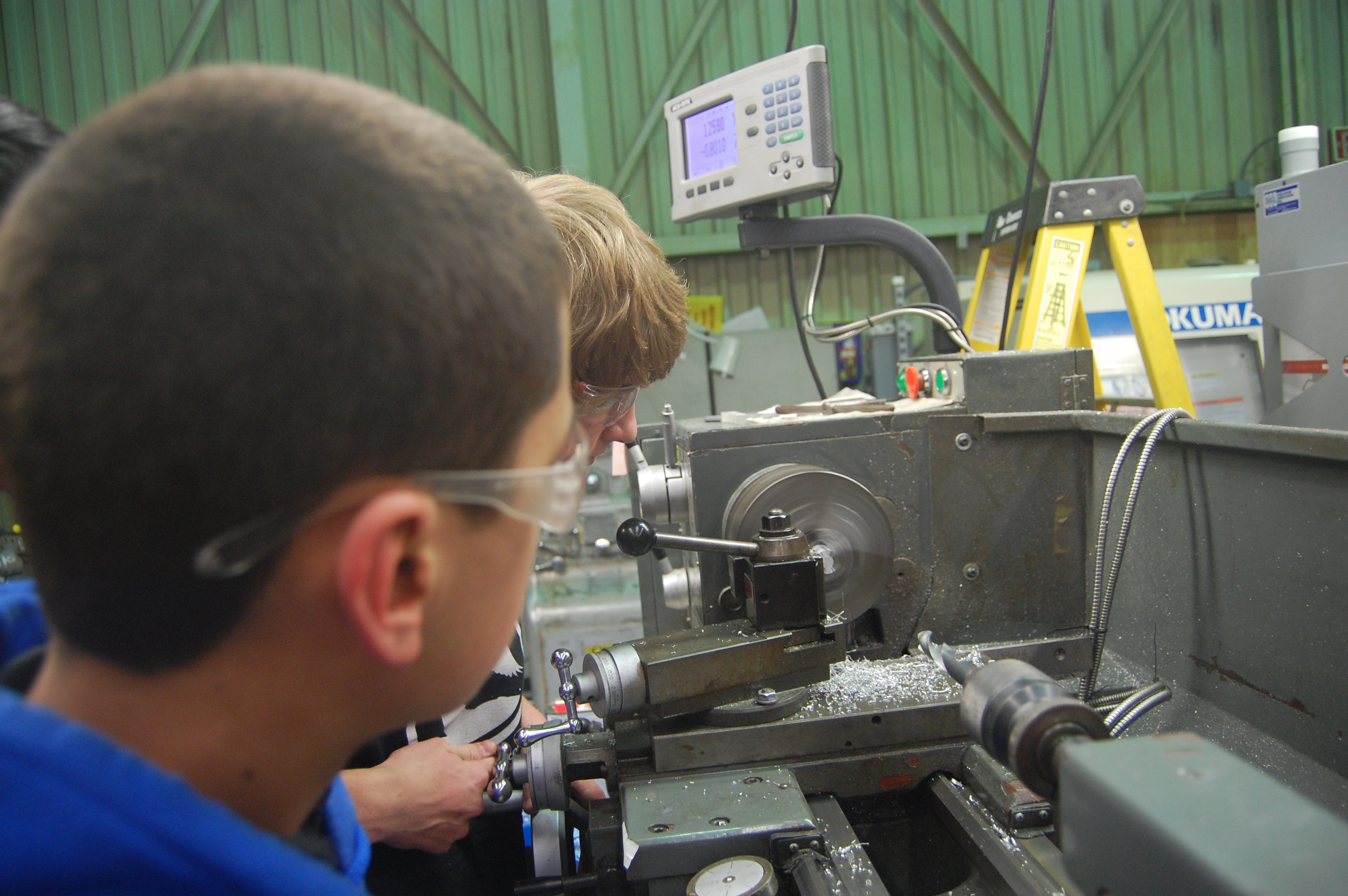
Shooter Prototype
A group of team members worked on further tuning the shooter prototype. They also performed several tests using different shooting angles and different distances from the goal in order to determine the optimum shooting distance.

Additionally, we began to improve the shooter prototype by adding reinforcements to the base and machining a new hood.

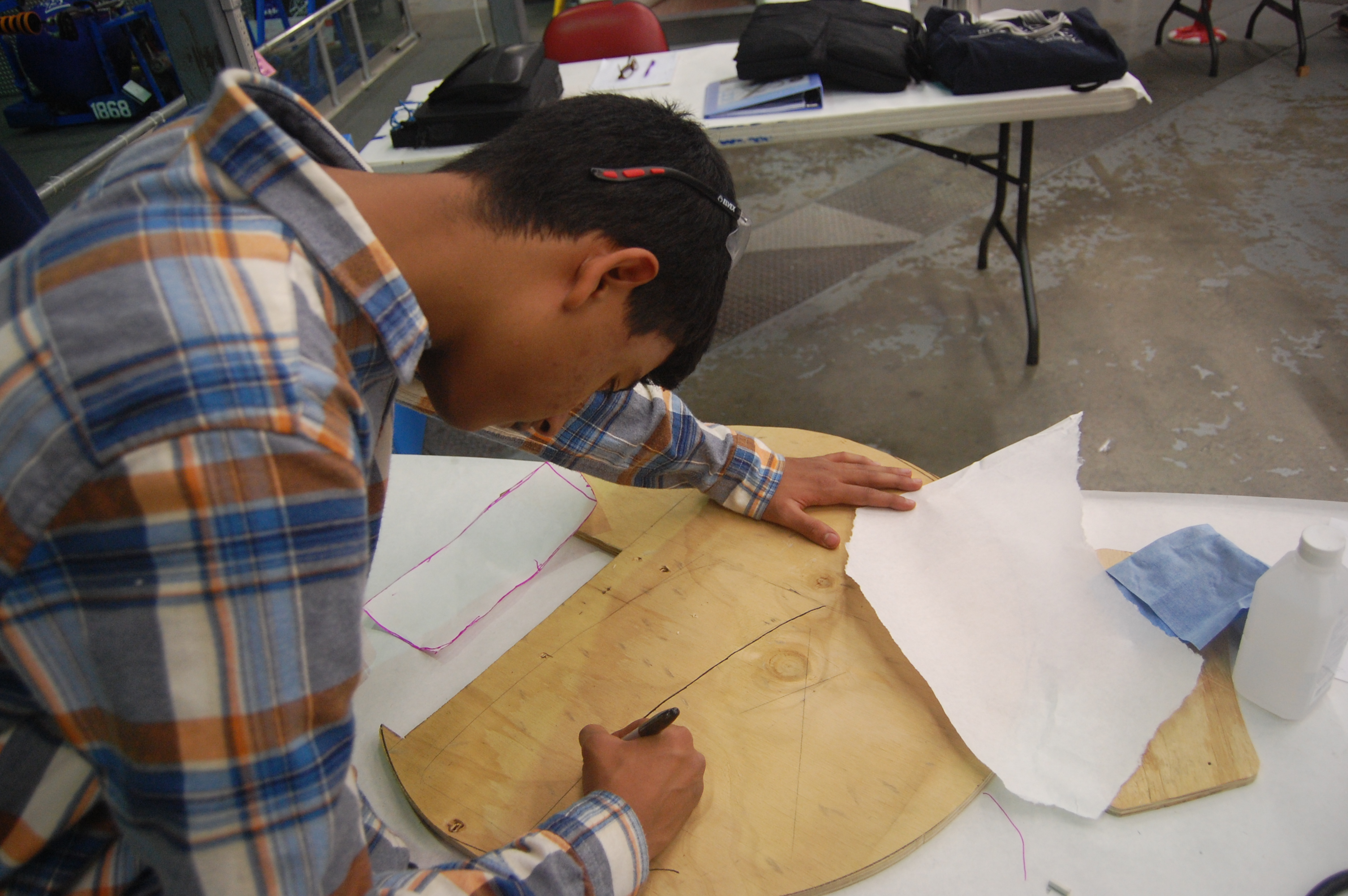
Prototype Testing
The groups working on the shooter and the integrated catcher and intake prototype came together to test whether or not it is possible for us to shoot over the truss using the current design. The conclusion is that the design will work, but it needs further tuning to be consistent. This test was done by using a “dummy truss,” also known as EJ.
The same group also tested whether or not it is possible for another robot to catch the ball as it is being thrown over the truss. The special constraint that we tested was whether or not the catching robot could start at the same position as the throwing robot and be able to drive fast enough to catch the ball. Although this robot has the same ratios as we are planning on using for the 2014 robot, it lacks a superstructure and is lighter, resulting in superior acceleration.
CAD
Work continued on the design of the drivebase for the robot. Right now the drive base is functionally identical to the previous year’s drive base. The only major changes have been the mounting points for the superstructure, which have been moved closer to the bumper mount to allow for a superstructure wide enough to hold the large balls in this game.
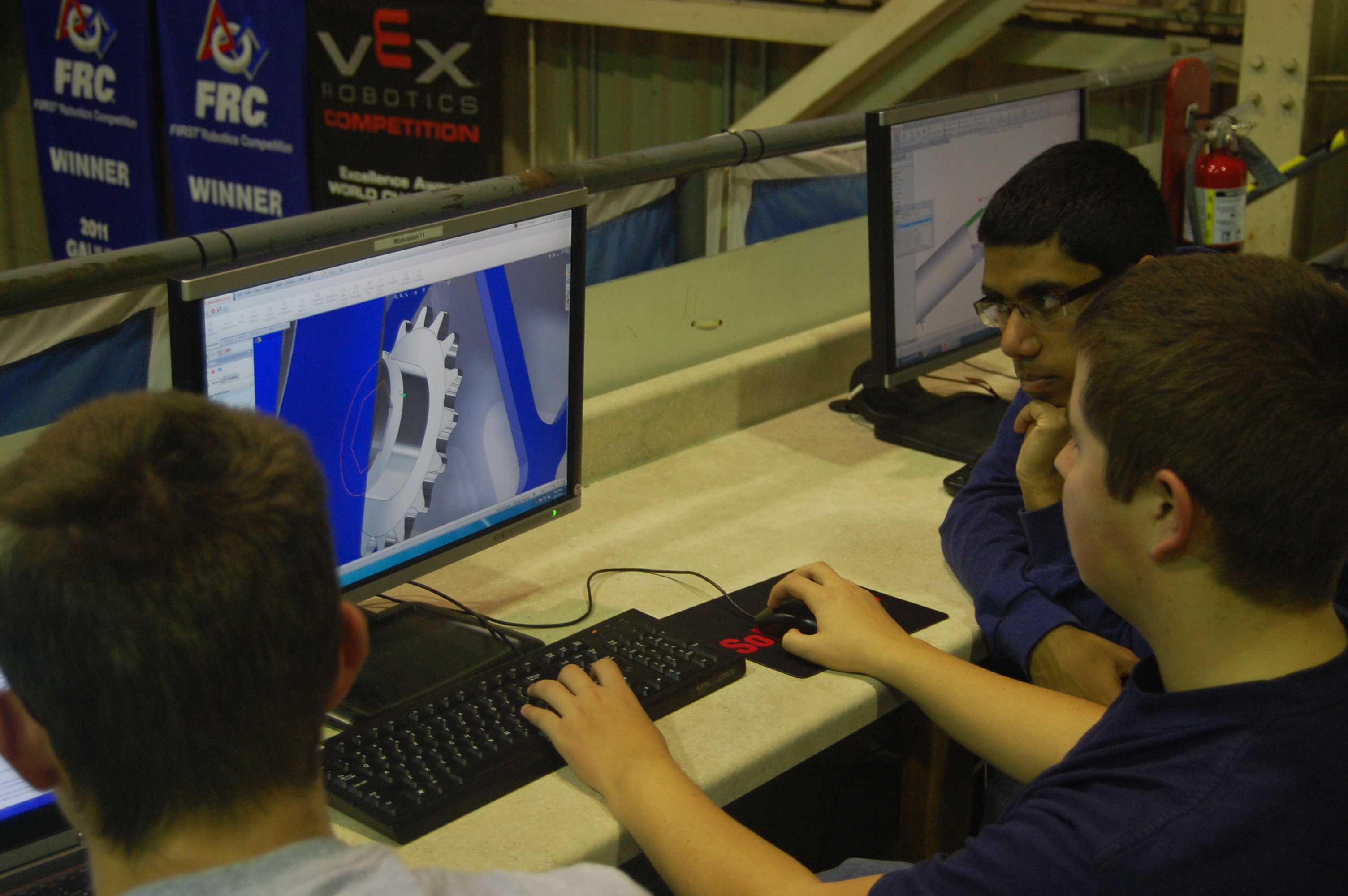
The team also got together to design the look of the rest of the robot. They discussed how to integrate the two intakes, the shooter, and the catcher into the robot and the overall design of superstructure. Right now there is a rough idea of how the robot should look. Further detailing will be based on the results of prototyping.
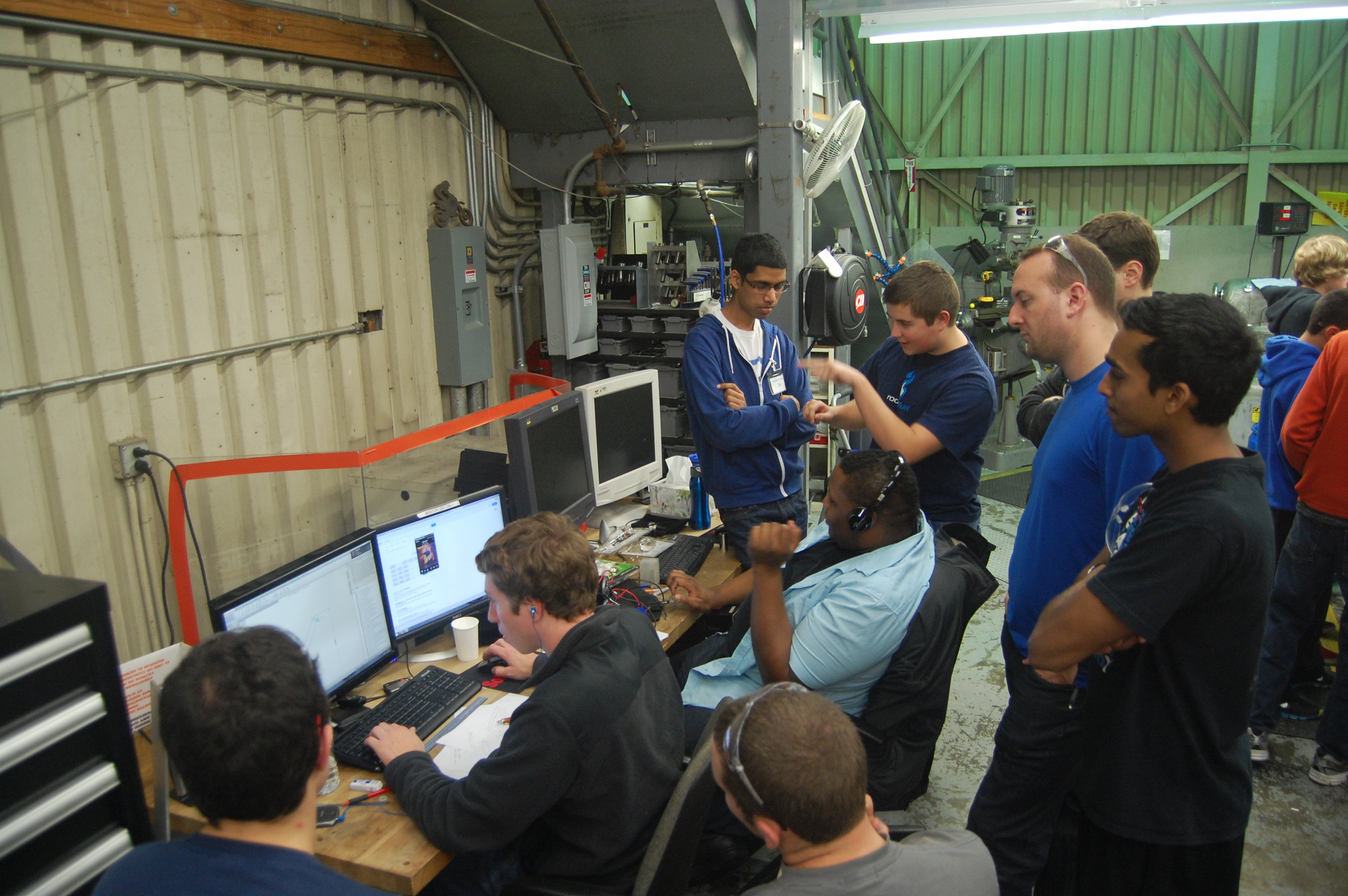
Lab Improvements
Today, we also worked on installing better light fixtures over the metals fabrication area in the lab. This will improve the lighting of the area, which will also improve machine quality and safety.

Manufacturing
The center bearing housings for the drive base were finished and polished today. As a result the manufacture of additional parts will begin.
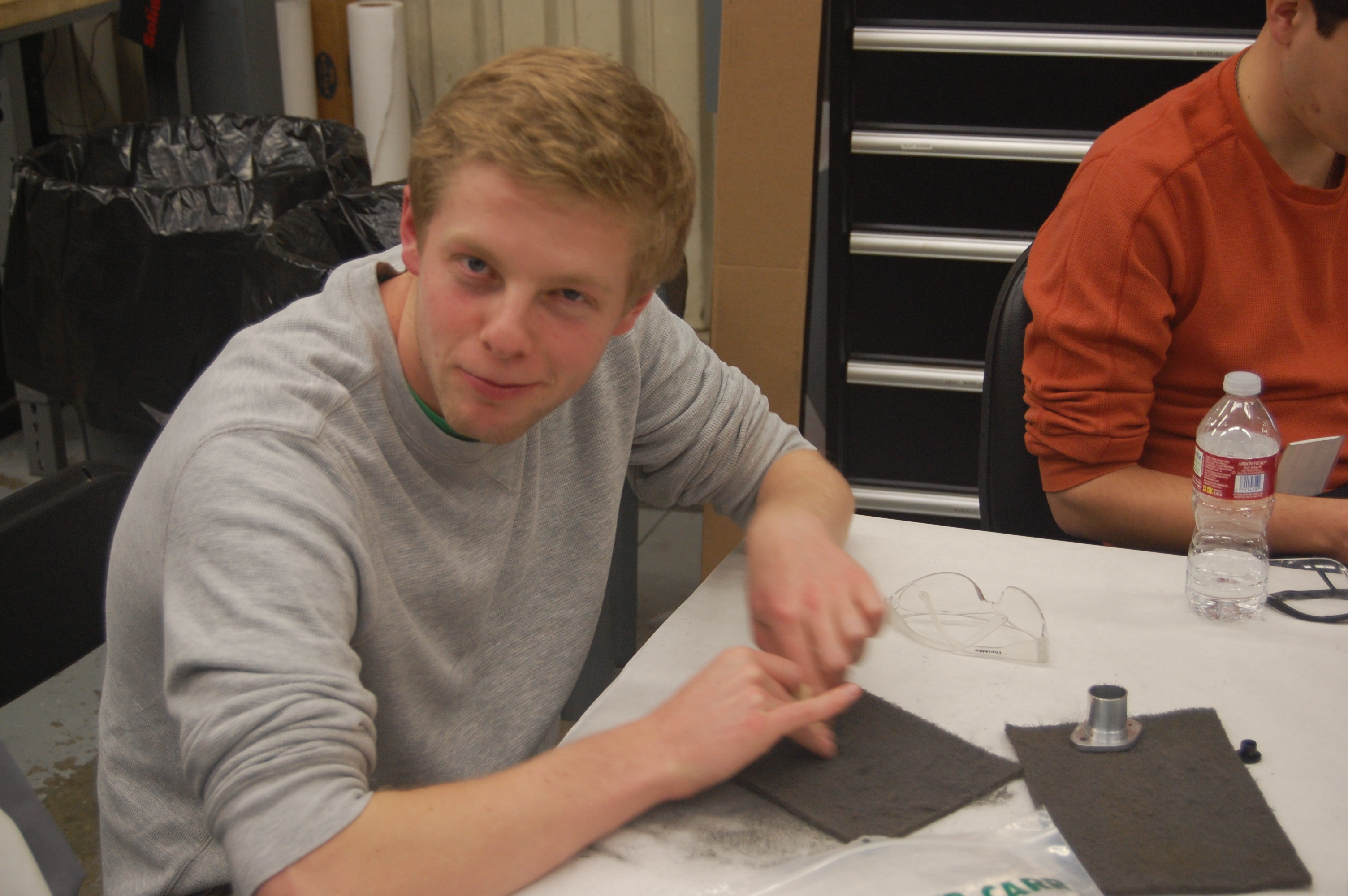
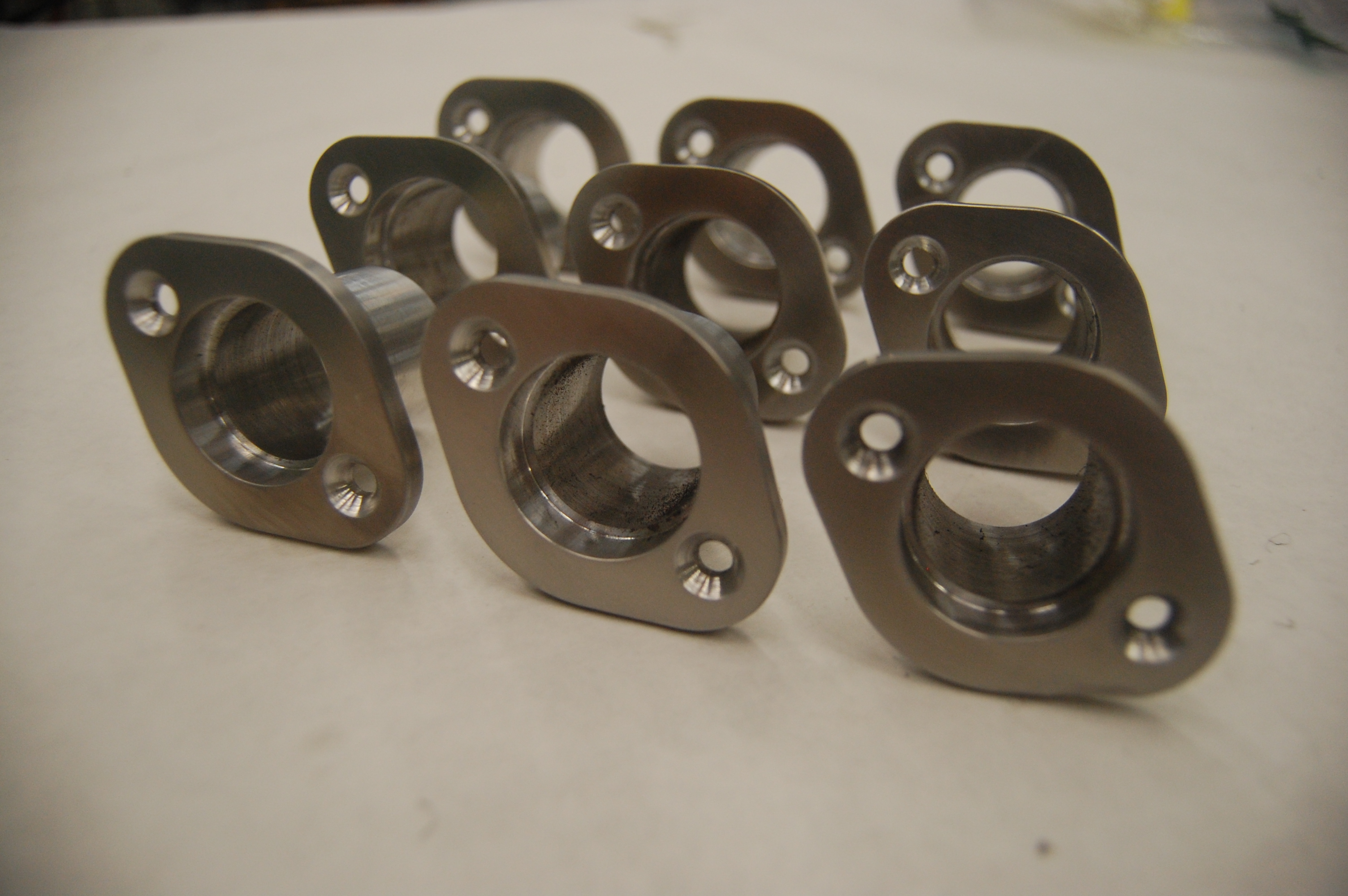
Action Items
- Continue testing shooter prototype
- Finish manufacturing new intake prototype
- Finish drive base CAD
- Send baseplate for manufacturing
- Continue designing rest of the robot
- Begin manufacturing parts for the drive base
Day 6: Prototyping the Catcher, Building a New and Improved Flywheel, and Organizing Parts
by Jeffrey Kaufmann
New Flywheel Prototype
A team of students worked on the updated prototype of the flywheel shooter. The new prototype can shoot at an almost vertical angle, enabling the robot to toss the ball over the truss. It also allows for easier packing because its flywheel is smaller than that of the first prototype yet still retains the positives aspects of the original. Some problems occurred during the construction of the new wheel such as broken or splitting wood pieces delaying completion.
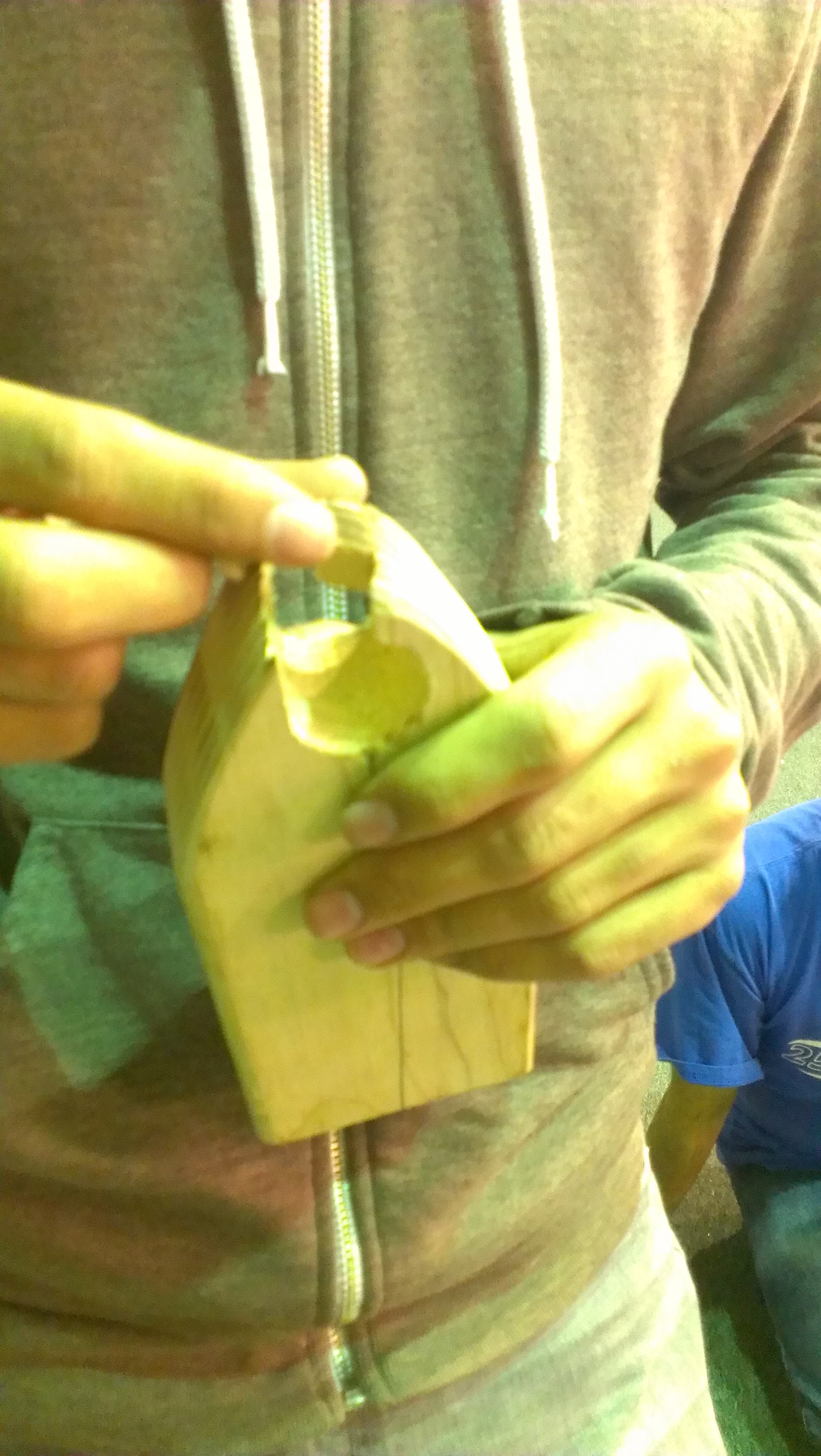
This piece had to be replaced. The team attached the curved piece of the flywheel that allows for an approximately 45 degree trajectory.
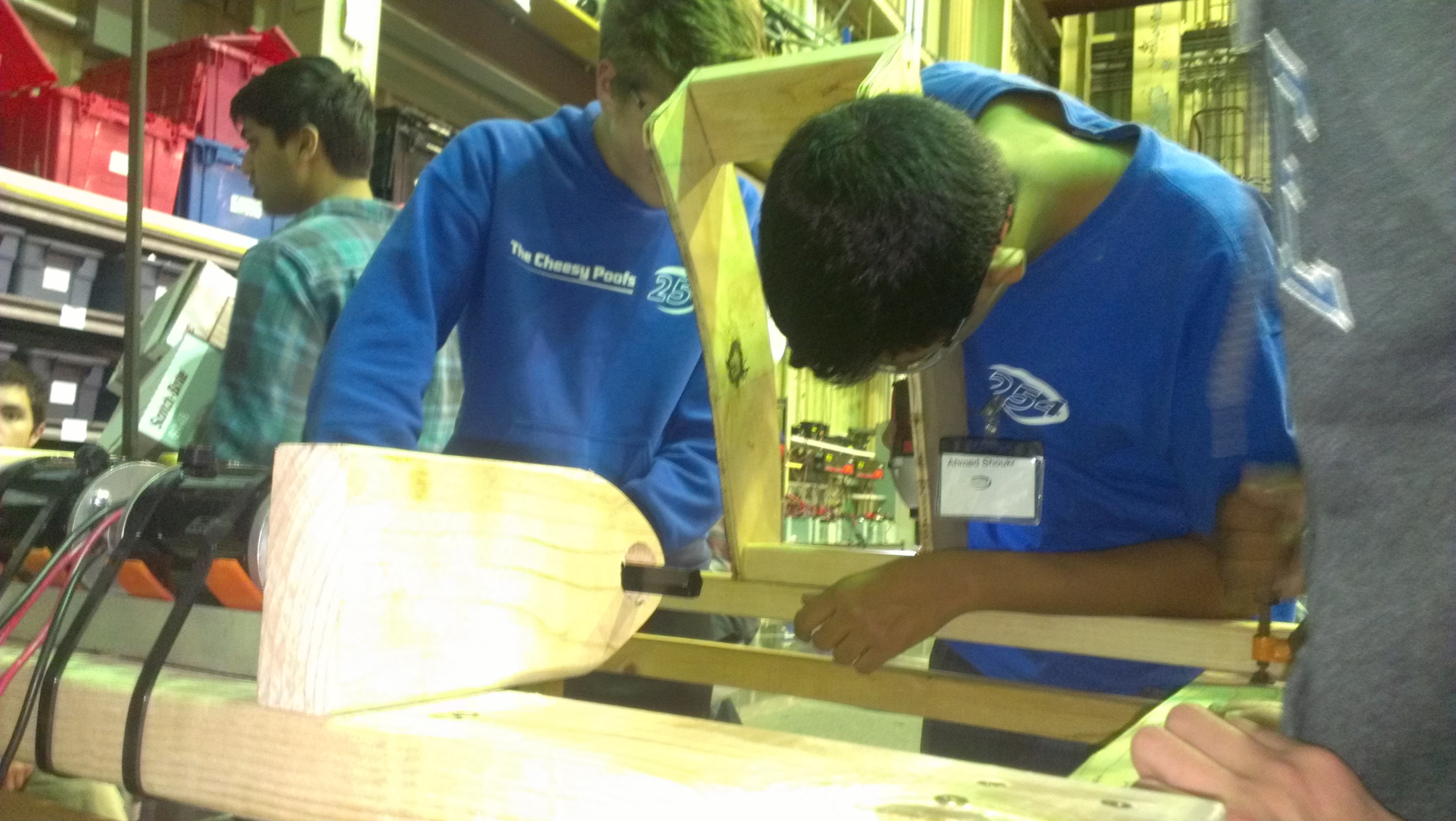
New Catcher Prototype
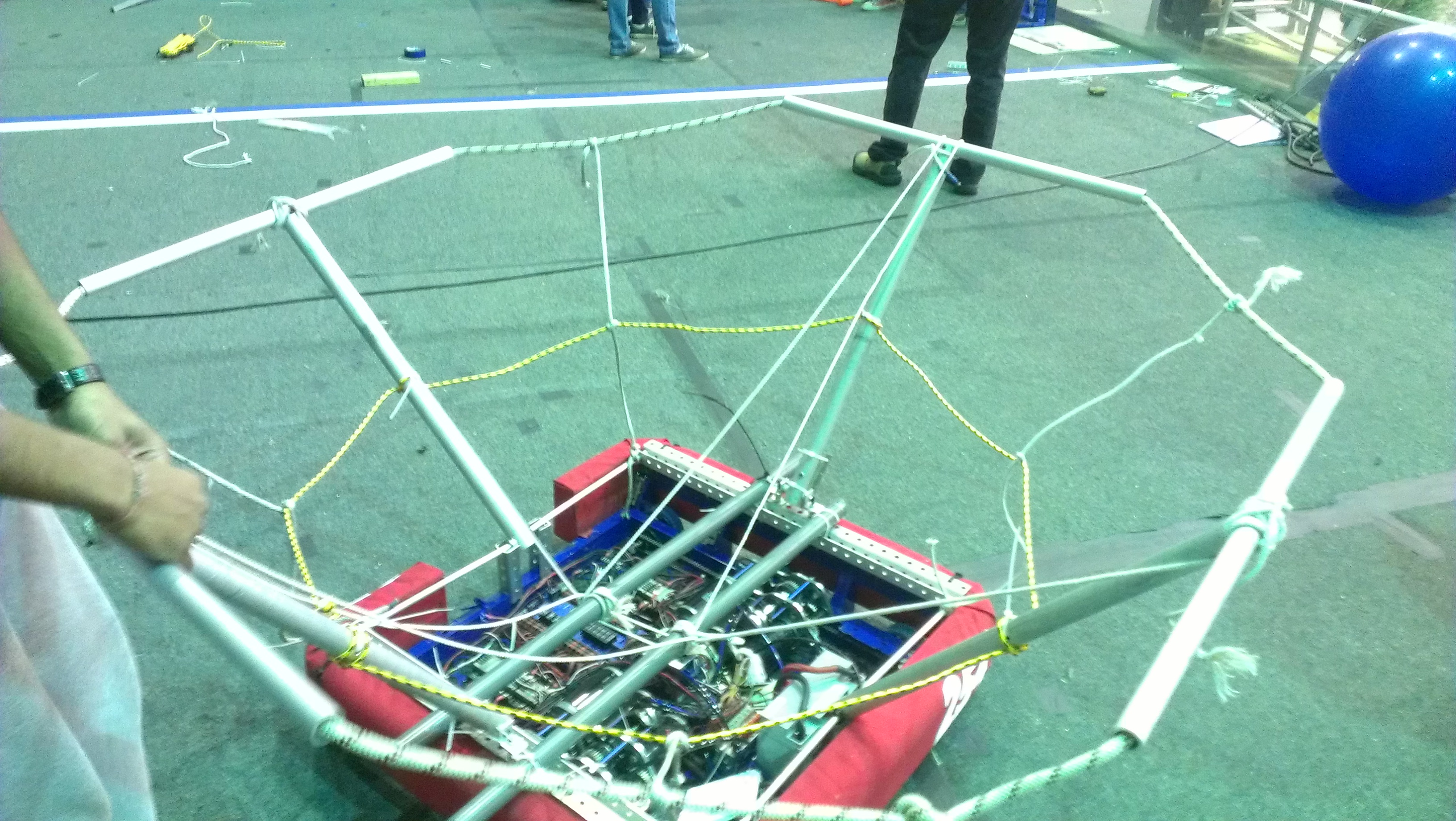
A group of students worked on fixing the second catcher prototype. This update will allow for a more mechanically robust device. The rope on the catcher and add a few metal pieces were overhauled today, resulting in a tighter, more stable and cleaner design.
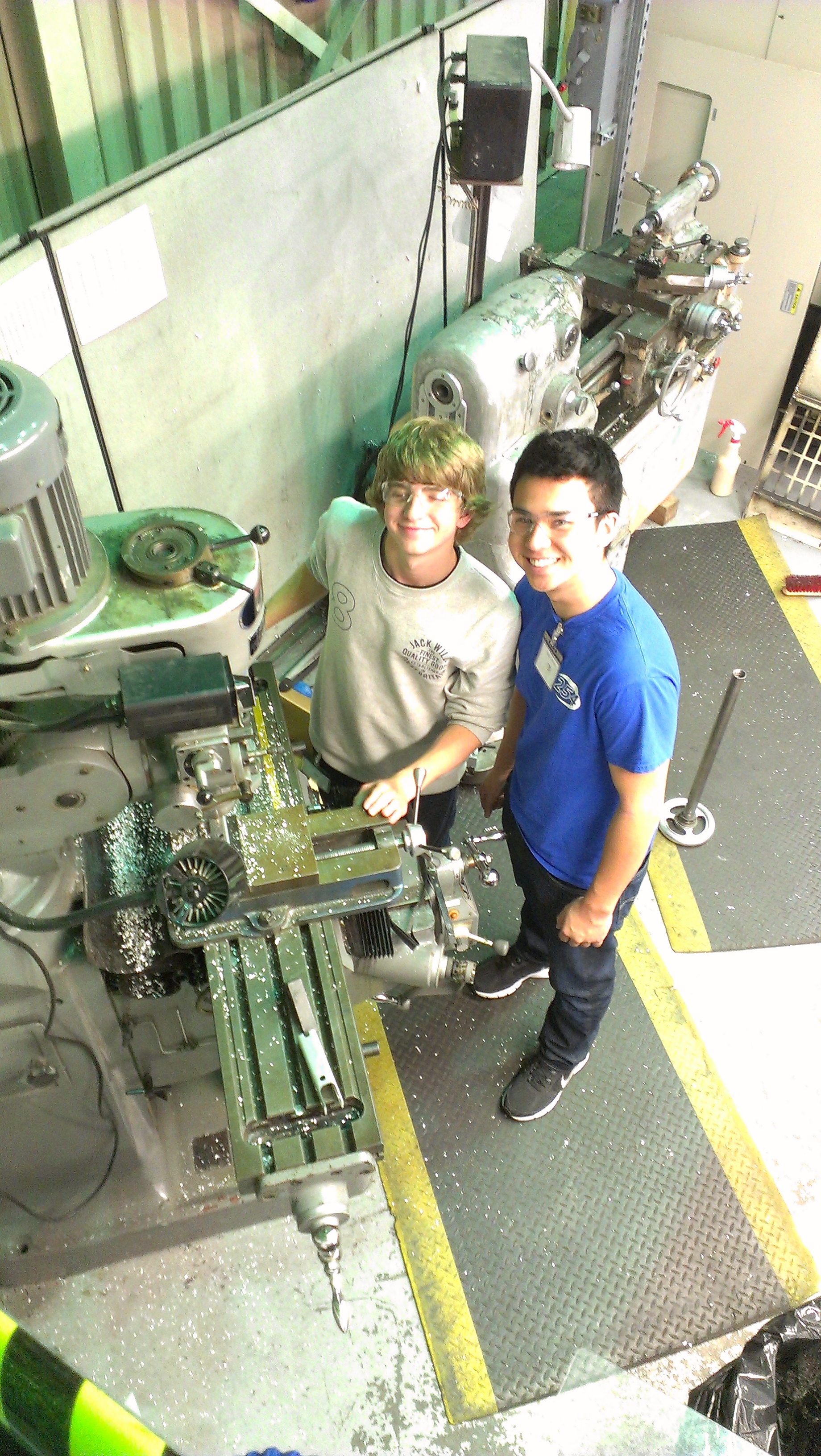
After testing the new mechanism while driving the results were quite satisfactory. The great mobility of the drive granted the ability to quickly get underneath the ball and receive an almost perfect catch.
Programming
The programming team worked hard on the coding on day #6. Today they made it so that the robot can now serve HTML pages. Furthermore, they had to refactor some of the code. In conclusion, while they had to restructure the code, this change did not affect how the code behaved.
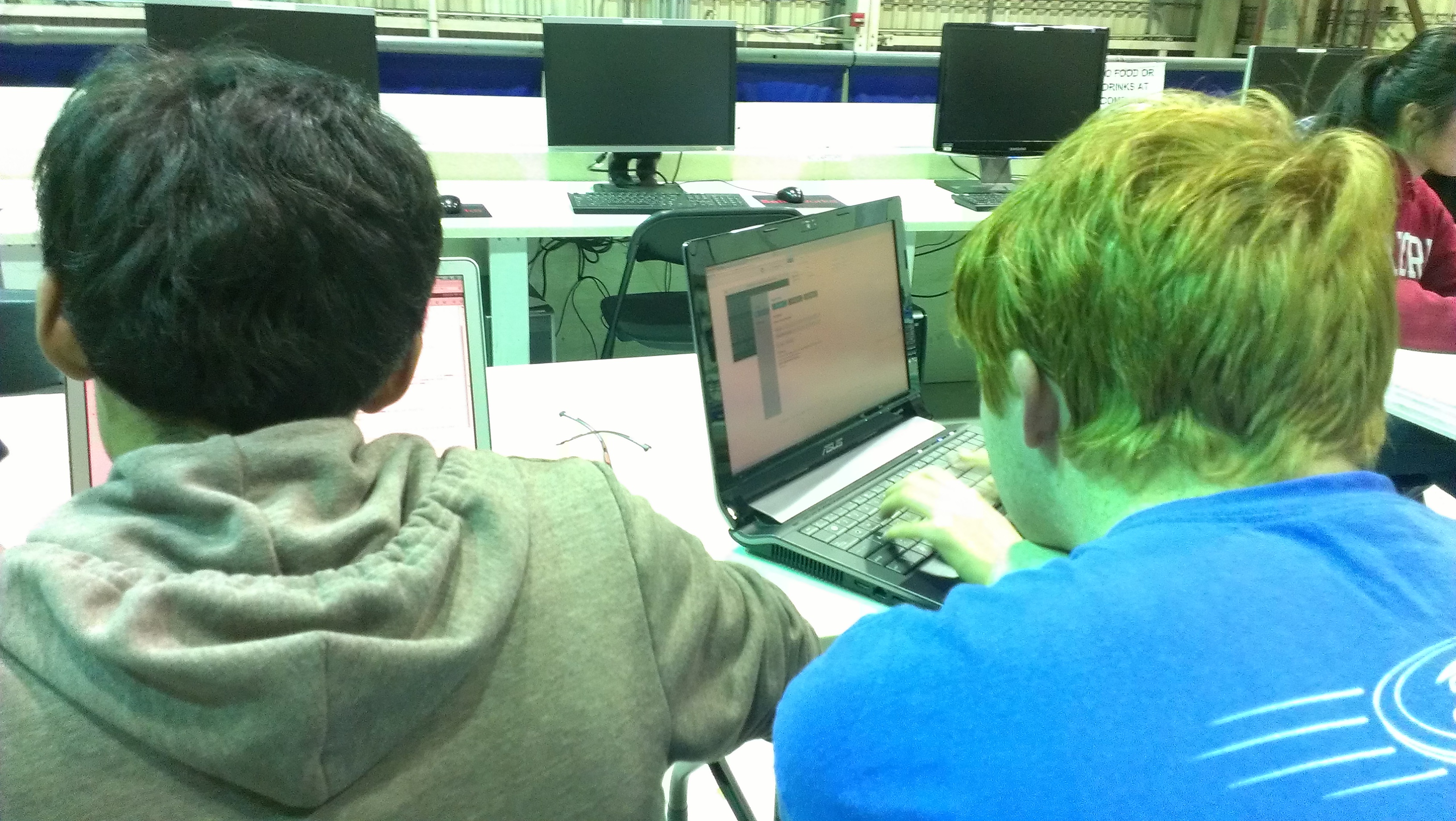
Organization of New Equipment
Recently, we received new equipment for the lab, such as soldering devices and other tools. Several students helped organize these new parts and categorized everything received into an Excel document, creating in effect an organized system of all the new equipment within a neat document.

Action Items
- Continue helping Abhi and Dan with catcher prototype and an add intake system.
- Continue helping Ahmed and Paul with shooter prototype improvements
- Continue testing
- Continue working on the drive base CAD with Andrew
Day 5: More Prototyping and Gearbox CAD
Flywheel Shooter Prototype
Today, we continued work on a new flywheel shooter prototype. The team determined that smaller shooter wheels would make the shooter more packagable in the robot. We made some great progress and we should be able to complete it tomorrow.
Design
Work continued on the drive gearboxes today. Based on the results of the simulation discussed yesterday, we decided that we would move forward with 2 3 CIM motor gearboxes but would also design 2 CIM motor gearboxes that could be swapped in if necessary. Although this would reduce acceleration, it could lighten the robot by up to 8 lbs.Today, we added the Bimba pancake pistons to the two speed gearbox assembly. We are moving forward with the previously discussed ratios of 4.2:1, 19.6ft/s in high gear and 10.6:1, 7.6ft/s in low gear. The CAD is almost done and is only missing a few components.
Programming
Today the programmers continued work on the graphing system for the robot. They worked on getting a TCP/IP server running on the robot and working out the technicalities of using a browser to monitor the stream of data from the robot.
Action Items
Finish Gearbox CAD, begin finalizing Drive base CAD
Day 4: Prototypes, Coding, Drive base design
Catcher Prototype
Today, we continued work on the catcher prototype, making it higher and wider so that it can better catch balls from all angles. Although the catcher is promising, its large size may be a problem when packaging mechanisms for the robot.
Catapult Prototype
The catapult prototype was finished today. The shooter is very smooth and can be easily reloaded in less than 5 seconds. It is consistent and accurate from up close (~2 ft from high goal) but mediocre from midway to the white zone. This shooter suffers from inconsistency in ball positioning within the catapult which could be improved with a better ball cradle.
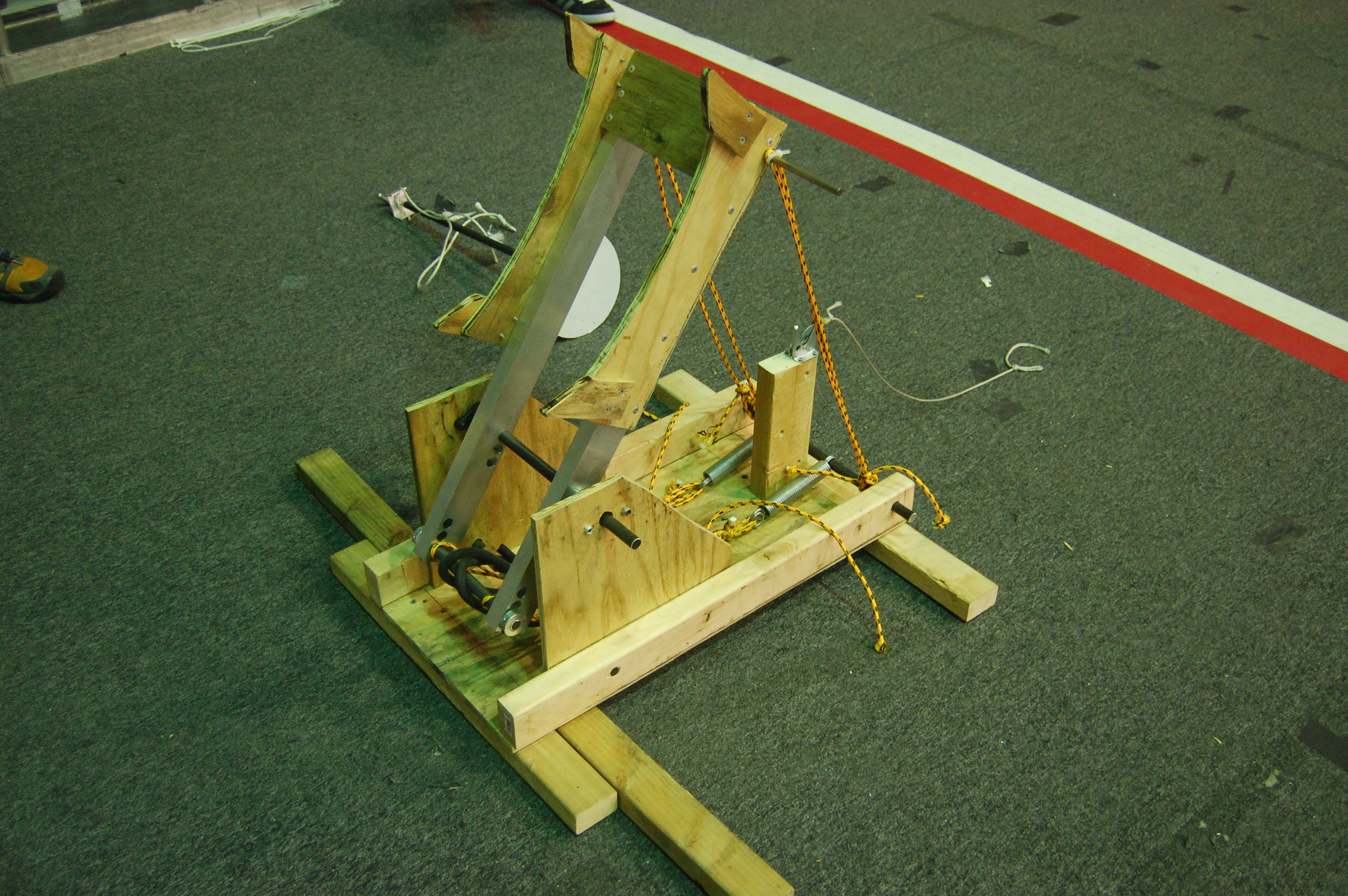
Flywheel Shooter Prototype
The flywheel shooter has been the most successful thus far with accuracy, precision, range, and simplicity. Because of its success (especially in scoring all 3 balls in under 5 seconds), we took it apart to replace the large wheels with smaller wheels while narrowing it to maintain ball compression with the smaller wheels. We hope to test this tomorrow.
Programming
Today, the programming team worked to get the 2013 practice robot up and running to test the drivebase. Several problems were encountered along the way. First, they had an SDK error on the robot which took them a long time to fix – eventually a cRio reflash solved the problem. Second, there was a problem with the wiring on the robot so they weren’t receiving any data from the TCP server. They eventually fixed the problem and now they are working on a way to graph the data from the robot in a quick and easily readable way.
Over the next few days they will also work on are prototyping some autonomous for the robot as we determined the autonomous is very important strategically.

Autonomous Strategy
We have determined that the autonomous period is critical to our success in Aerial Assist, allowing the robot to score up to 65 points. Because of this, we want our robot to be able to score 3 balls in under 5 seconds. The flywheel prototype is the most promising for meeting this objective.
Over the next few days, the programming team plans to start working on drivebase control loops for autonomous, using Overkill as a practice base.
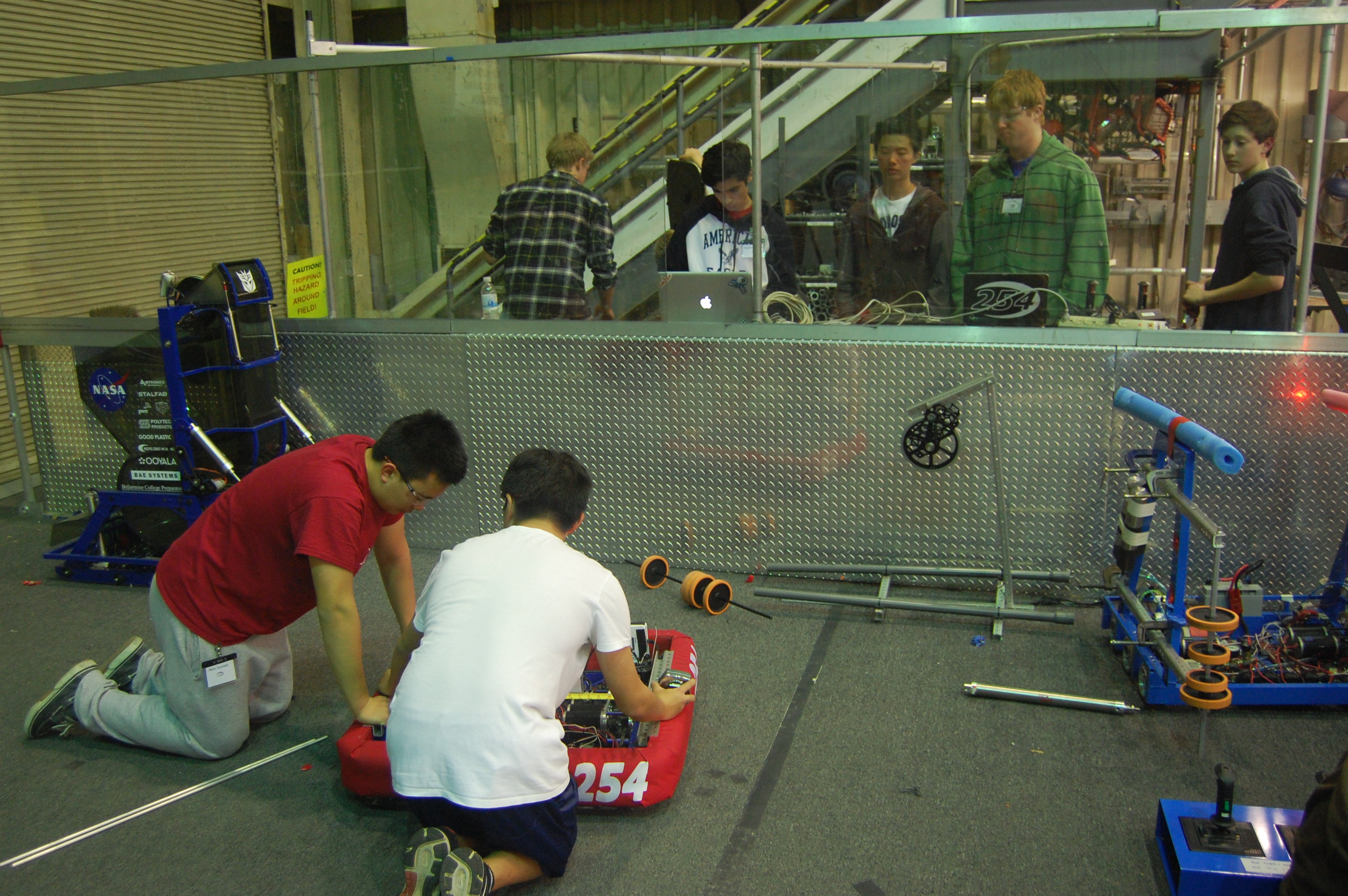
Drivebase Design
Today, work began on the robot drivebase, taking heavy inspiration from last year’s robot. The robot’s 6WD drivebase is the same overall size (28″ W x 27.75″ L) with wheel wells that can accommodate up to 1.5″ tread width. Today, we created a rough chassis in CAD and started work on the 2 speed drive gearbox.
The planned drive speeds are similar to last year (3 CIM motors per gearbox, 12:40 inital reduction, 15:48 low gear reduction, 28:38 high gear reduction, 3.5″ wheel diameter, 19.6 ft/s & 7.7 ft/s theoretical speeds). Due to the tight clearance between the 40T gear and the dog, the outer diameter of the dog will need to be reduced somewhat. Overall, this is a very similar gearbox to last year.
To determine the acceleration performance of our planned ratios, we performed a simulation of the drivebase accelerating. We decided to optimize the robot for 10-15 foot sprints and found that the ratios worked well with these goals. Furthermore, we found that while the 6 CIM drivetrain could reach 10 or 15 feet 10-20% faster than the 4 motor drivetrain, it drew much more power and could lead to premature battery drain.

Action Items
- Test flywheel shooter prototype.
- Test intake prototype with Mani.
- Continue working on drive base and gearbox design with Nagy.
- Compare all 3 shooter prototypes and decide on which we want to use.
- Continue work on drive code and autonomous planning with Stephen and Brandon.
Day 3: Prototyping continued, Autonomous strategies, and more
Autonomous Strategy
Today, we discussed scoring all three balls in autonomous. In autonomous, only the area directly in front of the low goal is guaranteed to be undefended. The strategy would involve starting with one ball in the robot, one in front and one behind. The robot would immediately drop an intake on each side of the robot and drive to the hot goal to score, dragging the balls with it. We also discovered that a banner sensor was able to pick up the reflective tape, meaning that the robot wouldn’t need to a camera to detect the hot zones.
We discussed whether it was more beneficial to shoot from afar or really close to the goal. Several team members proposed that shooting 2-4 feet away would be best since it would more than likely increase the robot’s accuracy. The fly wheel shooter was set up about 3-4 feet away from the goal and was able to successfully score
Catapult Prototype

A group today worked on a catapult prototype. A good amount of progress was made and it seems to be coming along well. The only things left to add are the rope, springs and hard stops.
Ball Catcher
Some of the students worked on a basic catcher prototype, making it from PVC pipe. They added a funnel to the top to increase the likelihood of the ball going in. It worked out well with some minor strengthening.
Programming
The programming team worked on a basic autonomous runner that uses threading. In essence, it allows for commands to be run while still allowing evaluation to occur. Also, in the event that a command should fail or timeout, the robot will skip the rest of the commands. One of the ideas that was brought up was separate compilation for the main code and autonomous routine to allow for quick changes to the autonomous without having to recompile the whole codebase.
Day 2: Prototyping, Drive base Design, Initial Coding
Prototyping Shooters
Three different teams worked to design, build, and test three different ways to launch the ball. They built a catapult, a linear launcher, and a flywheel shooter.
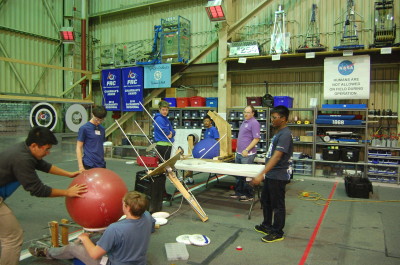
Catapult Launcher
A catapult was designed and built today using a system similar to other catapults we’ve seen for this year and 2008. This quick prototype was not strong enough to launch balls far enough and the team needs to improve the design tomorrow perhaps by making it more stable and utilizing another tension device such as surgical tubing.
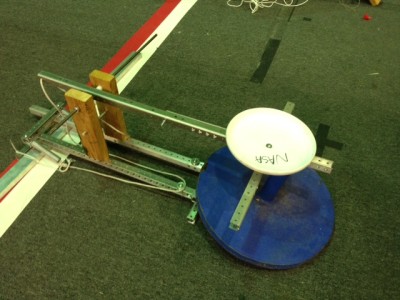
Linear “Trident” Launcher
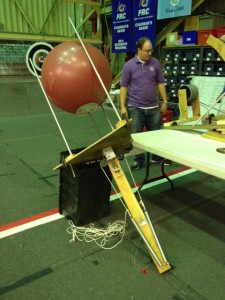
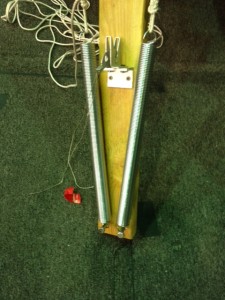
Flywheel Shooter
The flywheel shooter was completed today, and students and mentors began testing with it. Of the three shooter prototypes, the flywheel had the best shots and most consistency. Additionally, the team could test the effects of ball pressure on the consistency and accuracy of shots for the first time in the season. By the end of the night the flywheel shooter made about 1/3 to 1/2 of its shots.
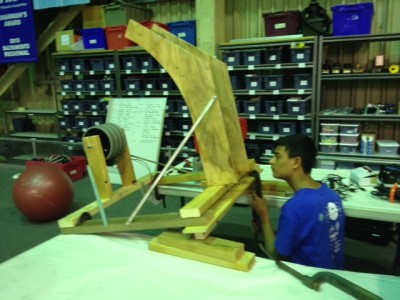
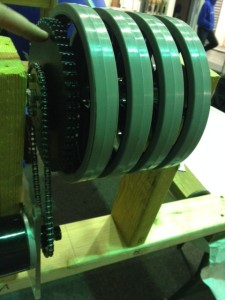

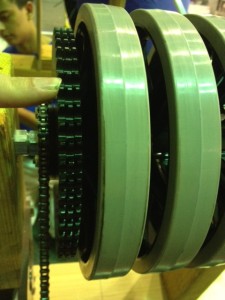
Programming
The programmers met today and decided on what they wanted to work on for the next few weeks.
It was decided that we would like to spend time building debugging tools for the robot. The main thing that needs to be built is a way to live graph motor and sensor states, much like the PID tuner we had in 2012.
The programmers also decided to rework how autonomous mode will be executed so that control flow can be used in autonomous rather than just a straight sequence of events.
Tom and Stephen started a new Java project for the 2014 robot and got basic CheesyDrive working on the 2013 practice drivebase. This code will use a new subsystem architecture and will use very little code provided by WPI.

Field Assembly
The team completed the construction and mounting of one full set of high goals. The goals have a ramp designed to return the balls back onto the field so that they do not fall onto drivers. We will use these wooden goals while we wait for the official set to come in from FIRST.
Drive Base Design
Today, the team began modeling parts for the gearboxes and chassis. We plan to design a drive base similar to last year but without a PTO on the gearbox. Tonight, we designed the gearbox output shafts, intermediate shafts and wheel shafts which will be sent out to sponsor Modern Machine Company tomorrow.
Action Items
- Continue gearbox design
- Continue testing and improving flywheel prototype.
- Continue testing puncher prototype, try to increase power.
- Rebuild catapult prototype, must be stronger and more stable.
- Programmers continue improving drive code and autonomous tuning with Tom.
- Improve catcher prototype with Dan.
- Possibly begin machining parts for the drive base.
Day 1: Kickoff and Game Analysis
Kickoff Overview
Today kicks off the 2014 FRC Season for Team 254. The mentors and students are equally ecstatic for this year’s challenge, Aerial Assist.
Google Drive PDF of the Game Manual:
https://drive.google.com/file/d/0B_TTQ23_FVkAWjM0cjBsbUw1TkU/edit?usp=sharing
Game Animation:
Team Kickoff
Today a group of students attended the 6:30 to 9:30 local San Jose kickoff at Morris Dailey Auditorium. A few others watched the NASA Live Stream from home. Subsequently, at 10, the team met for the team’s kickoff event and discussed the plan for the coming six-week build season. The team then broke up into groups and discussed strategies in terms of necessary robot qualities, priority tasks, and possible scores. The parents and mentors simultaneously discussed logistics and the build plan in more detail until the student leaders returned to present their ideas to the entire group.
Game Analysis
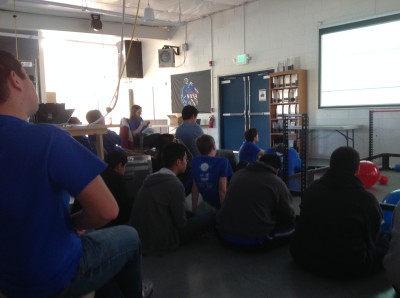
After lunch, about 70 students congregated in the Bellarmine Robotics Lab to examine and better understand the team rules. In particular, they discussed the definitions of assist and possession and clarified the rules for such actions and others on the playing field. For the first two and a half hours, the group went through the relevant sections of the game manual and encouraged group discussion to find possible holes and list them to check with FIRST later. The group noticed some deviations in rules from previous years: the field is two feet narrower at 25 feet, and the match is 30 seconds longer. The autonomous period is five seconds shorter at 10 seconds, and the tele-operated period is 35 seconds longer at 2:20. Andrew Torrance noted the possible issues with battery life with the 25% longer match time. In addition to discussing rules, the team also formulated questions concerning the regulations to ask FIRST:
- Can teams do assists in autonomous?
- Can teams hold balls in autonomous to do an assist later?
- Can a team throw over the truss again to try and get a catch, say, if an alliance earns a successful truss score, but does not successfully catch. Can the alliance try for a second chance? In other words, while the group recognizes that only one truss score counts per cycle, do the truss score and the associated catch score have to be earned on the first attempt?
- Do teams get points (ex. throwing and catching in the end game) immediately, or do the teams only get them once the cycle completes? This is related to the question of assisting in autonomous. Possible answer: Maybe not because autonomous shots are not cycles.
- Teams need clarification on which goalie zone to which the initial position regulations refer. In which goalie zone do teams start if they do not want to start in the white zone? Can human players help in the middle of assists?
- Can human players catch truss scores to make them legal?
- Teams need a better definition of possession for robots in general. For example, for a trough-like robot, is holding the ball as it rolls considered possession? What time period differentiates harmless “deflection” from “possession” of the opponent game object (which earns a severe technical foul penalty)
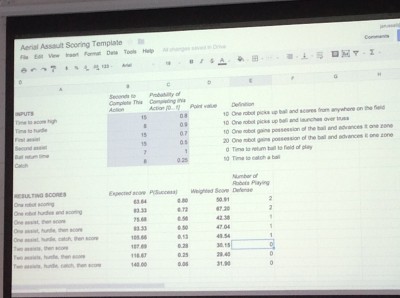
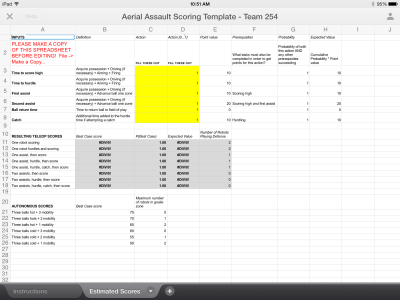
After a short break, the team’s new mentor Jared set up a Google Spreadsheet that evaluated the effectiveness of certain “assist” strategies, with combinations of 1-3 assists, a truss “hurdle,” and the truss “catch.” He took student input for the point values corresponding to each action, the expected time taken for each action, and the probability of the action being carried out successfuly. He then calculated out a rough model of the weighted point values expected from strategies in the tele-operated mode of the match. The group was then able to analyze the efficiency of certain strategies. In the process of discussing strategies, the team also created two other strategy charts and lists (pictured).

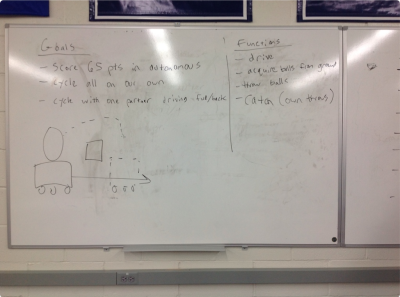
Further Analysis and Prototyping
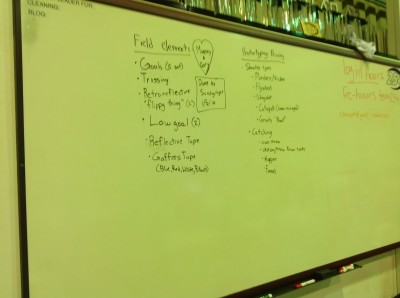
After dinner, approximately 20 students worked with the mentors to list some possible designs and to plan out the next week’s prototyping schedule. The group prioritized the prototyping of possible modules, specifically shooter designs and catching mechanisms, with design input from students and advice from our experienced mentors. They also discussed what field elements were most necessary for prototyping for the next few weeks and listed them as well. Finally, they discussed the mathematics and physics of shooting a 25-inch, compressible, bulky, and irregular projectile into a 3-foot goal. For example, mentors noted that we might as well design a robot to shoot from farther away from the goal, since the shallower angle of entry would give greater allowance for error. Mentor Paul Ventimiglia also determined that giving the large exercise ball some backspin helped in precision, though it also required more energy to apply both linear force and rotational torque.
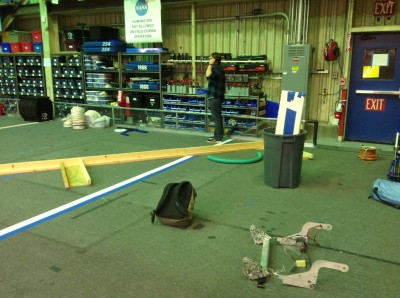
Tonight, we mainly focused on the building a preliminary goal with which to prototype before the field arrives and on prototyping and testing the effectiveness of a flywheel shooter and a slingshot shooter. Paul worked primarily with Godwin Vincent, James Holden, Jeremy Tanlimco, Vidur Maheshwari, Miggy Francisco, and Joncarlo Avila to design, sketch, and begin building a prototype for testing the effectiveness of a flywheel on such a large game object. They determined the best wheels with which to work based on their ability to grip the surface of the unusual game object. The prototype design was finalized and they plan to use four large wheels on the same axle hooked up to curved plywood “rims” to optimize the compression on the ball and somewhat minimize the size of the already bulky prototype. EJ Sabathia and Noah Marcel worked on the slingshot design, taping a 2013 Ultimate Ascent Frisbee to surgical tubing and hooking up the system to an alliance wall. The ball consistently bounced about 1/3 of the way down the court, given about 4 or 5 feet of backward stretch.
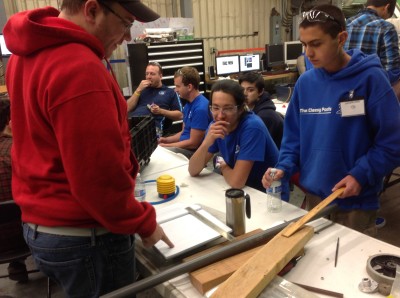
Lab closing time: 11:00
Action Items
Translation: Future Work Opportunities for Members
- Help Paul with the Flywheel Shooter design
- Help EJ with Slingshot Shooter design
- Help Nick Mercadante machine metal for prototypes
- Ask mentors to begin and lead prototyping projects for other designs
254A receives Excellence at Bakersfield VEX Tournament
On Saturday, December 14th, VEX Teams 254A and 254F competed at the Frontier Titan Robotics Tournament in Bakersfield, California.
Our teams had some tough matches in the qualifying rounds, and even had to go against each other. Despite that, 254A went undefeated and seeded 3rd, while 254F seeded 13th.
254F was picked by the 2nd seeded team, 563, Titan Robotics. This alliance later picked Team 1437X, Patriot Robotics.
254A picked 1437Z and then 1437Y, Patriot Robotics.
After easily getting through the quarterfinals, 254A had to face 254F in the semifinals. 254A ended up narrowly advancing to face the number 1 seeded alliance featuring teams 21D, 21, and 1837A. In the finals, robot problems plagued 254A’s alliance in the first round. Then, in the second round a field disconnect occurred that resulted in 254A, 1437Y, and 21 being disconnected and only 21D left to play the match by themselves.
During the awards ceremony, Team 254A was given the Excellence Award for their outstanding performance in Qualification Rounds, Robot Skills, Programming Skills, and presenting their Design Process. This means that either 254A or 254B (who received Excellence at the Bellarmine VEX Tournament) are eligible to receive the Excellence award at the State Championships in March.
Modesto VEX Tournament
On Dec 7th, five of Bellarmine’s VEX robotics teams competed at the Central Valley VEX Robotics Tournament. Although our teams had a few tough matches, often competing against each other, four of the five teams made it to eliminations. 254G placed third in the ranking, and 254D placed 15th. 254G joined 21D and 254E to form the 2nd alliance and 254D joined 2367 and 2367B to form the 7th alliance. Both faced each other in the quarterfinals, and 254G and 254E advanced to the semifinals.
In the Semifinals, 254G and 254E faced 8000A, 8000B, and 8000C. They managed to win the first game 37-36. Because of some connection issues they were defeated in the second match, and were unfortunately eliminated in the third match.
In the skills challenges, 254E scored 15 points in Programming skills and 57 points in Robot Skills. 254C got 10 points in Programming Skills 254D scored 56 points in Robot Skills. 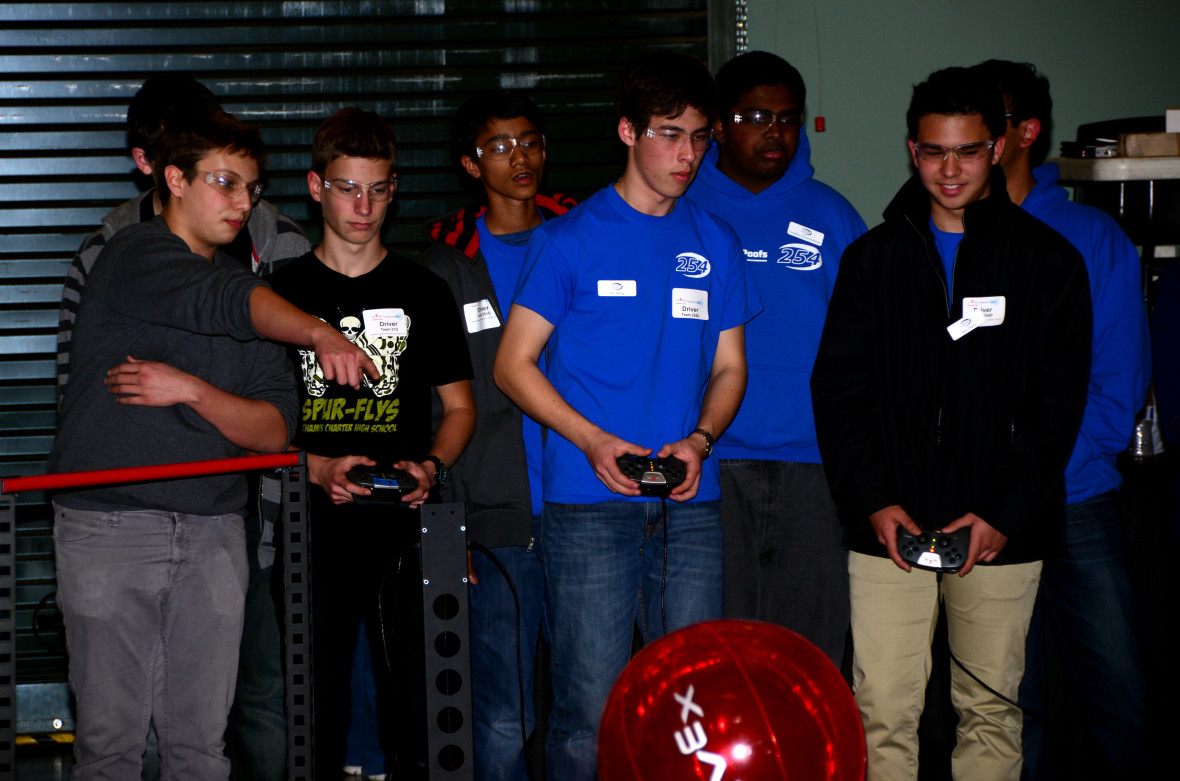
Bellarmine VEX Tournament
On November 22nd and 23rd, all seven of Bellarmine’s teams competed at the Bellarmine Bay Area VEX Robotics tournament. Our teams played well during qualification and four of our teams made it to eliminations. 254A, as part of the 8th ranked alliance, faced the 1st ranked alliance in the quarterfinals and unfortunately lost. However, 254F, 254G, and 254E, as the 4th ranked alliance, decisively beat the 5th alliance in the quarterfinals and simultaneously scored 76 points, the most points in any of the matches of the event. The all-254 alliance then faced the top-seeded alliance in the semifinals, and lost the first match by only 3 points.
In the second and third matches of the semifinals, however, the all-Bellarmine alliance staged a comeback to win the next two matches against the 1st-ranked alliance, securing the semifinals and a place in the final round of eliminations. The all-254 alliance subsequently plowed through the finals, winning both matches against the 2nd-ranked alliance by margins of about 40 points each. This decisive tournament win added 254E and 254G to the list of Bellarmine teams headed to the California State Championships.
Additionally, our Bellarmine teams accounted for the top three Programming Skills scores and three of the top four Robot Skills scores. Notably, Team 254A placed first in both Skills Challenges. More importantly, 254B won the Excellence Award, the highest award given in VEX competition. The award recognizes teams for their overall excellence in their engineering process and robot design, for their performance in Skills Challenges and matches, and for outreach, teamwork, and sportsmanship. With this significant achievement 254B will also head to the California State Championship. In short, after just two tournaments, five Team 254 teams have qualified for the State Championship, of which two (A and F) have qualified through multiple tournament successes.
254B is led by Eric Van Lare and Jeffrey Kaufmann
254E is led by Louis Lin and Dorian Chan
254F is led by Nick Verducci and Nathan Rooke
254G is led by Eric Wang and Goutham Gnanasekeran
Congratulations to our teams, and we wish them luck at the State Championship in March!
VEX Tournament Information for Competitors
The event is free for spectators. Below is information about the tournament, including details on the qualifications for the state and US national tournaments.
Outline
- Changes from last year
- Schedule
- Tournament Location
- Concessions & Pizza Order Form
- Awards Given
- Information for Competitors
- Information for Novices
Changes from Last Year
- There are more teams competing, so if you can, please get inspected on Friday evening.
- We have extended the hours for the skills challenge field. It will open at 7:30 on Saturday morning and stay open through 4:30pm. High skills challenge scores can lead to a berth at the California State Championship.
- Qualifications have changed and are described in the “Awards Given” section below.
Schedule
Friday, November 22, 2013
6 pm – 8 pm
Check-In and Inspection (in Liccardo)
6 pm – 9 pm
Practice time for teams
Saturday, November 23, 2013
7:15 am
Pit Area and Registration Opens (in Liccardo)
7:15 am – 8:30 am
Inspection (in Liccardo)
7:30 am – 8:30 am 7:30 am – 4:30 pm 8:15 am
Practice Rounds (in Sobrato Theater) Skills Challenge Field open (2nd floor Sobrato Theater) Check-in closes (Teams scratched that haven’t checked in)
8:30 am – 8:45 am
Driver’s Meeting (in Sobrato Theater)
8:30 am – 9:30 am
Sign up for judging interview (at Pit Admin table)
8:45 am
Welcome (in Sobrato Theater)
9:00 am – 12:30pm
Qualifying Rounds (in Sobrato Theater)
12:30 pm – 1:00 pm
Lunch Break (We will have Pizza Order Forms)
1:00 pm – 2:35 pm
Qualifying Rounds Continue (in Sobrato Theater)
2:45 pm
Alliance Selection Process (in Sobrato Theater)
3:00 pm – 5:30 pm 4:30 pm
Playoffs (in Sobrato Theater) Skills Challenge field closes
~5:30 pm – 6:30 pm
Finals, Awards, Closing Ceremony (in Sobrato Theater)
Tournament Location
Bellarmine College Preparatory 960 W. Hedding St. San Jose, CA 95126//mapq.st/17Jl2d5
Street parking is very limited due to permit parking restrictions. On campus parking is marked with red on the campus map (linked below). The green boxes on the map represent the pit area.
View detailed campus map (PDF)
Concessions
Pizza will be available for $15 a large pie from Tony & Albas. Please order your pizzas by midnight on Nov 20 using this form. Please pay for your pizza when you check-in.
The following items will be available for purchase in the Liccardo Center (8am – 3pm):
- Vegetarian Egg Rolls
- Variety of Donuts, Muffins,
- Fresh Fruit & Oatmeal
- Cheetos and Cheez-Its & Coffee and Tea
- Oreo Cookies & Variety of Juices
- Candy Bars & Bottled Water
- Cliff Bars & Snapple Iced Tea
- Caesar Salad & Hot Chocolate
- Cinnamon Rolls
- Samosas
Awards Given
We have 5 qualifications for the VEX US Open (Excellence, Design and the tournament champions). Those teams, along with the finalists, also qualify for the California state championships.
iDesign will be offering a $100 gift certificate, which will go to the team that receives the Judges award.
Note that the skills rankings will be used to identify all additional teams that will be used to fill the state championship event to its capacity of 48 teams. Every team should realize the importance of this opportunity.
Info for Competitors
If you want to be considered for the Excellence or Design awards, you will need to sign up for an interview by 9:30am. Go to the Pit Manager to schedule (or change your appointment time if needed). The interview rooms are on the second floor of the Sobrato Theater building.
The skills challenge field is also on the 2nd floor of the Sobrato theater building. Teams are not limited to the number of attempts, however, any team with fewer than 3 attempts can move ahead of other teams waiting in line.
Teams will be scratched from the tournament if they have not checked in by 8:15am. If you are running late, please text 408-341-9066 or email [email protected] before 8:15am, or your team will not be able to compete.
Bring safety glasses, power strips, tools, programming cables, engineering notebook, RECF releases (available at: //content.vexrobotics.com/epdocs/VRC_ReleaseForm_012011.pdf). Be sure your robot can pass inspection!
Info for Novices
It is highly recommended for you to arrive Friday to go through the inspection and try a couple practice matches. Friday will be much more relaxed and our inspectors will be able to help you through the inspection process. Also, our field managers will be able to guide you through the competition process. Be sure to bring fully charged batteries, chargers, spare parts and tools in case anything breaks. Be sure your vexnet keys are working well. Lastly, double check your robot against the inspection check list.
At the tournament, check in by 8:15am. Check the match schedule when it is published (around 8:35am) and make sure you are ready for each match. Try to have fully charged batteries for each match. Be sure the drivers and coach have safety glasses when they arrive at the field to compete.
More information on the game is at the RobotEvents website. The current rankings for Robot Skills and Programming skills are listed there also.
VEX Tournament Map
The maps below show the tournament facilities located on the campus of Bellarmine College Preparatory. The red boxes denote campus parking, and the red lines show the best way to the parking spots. Green boxes identify the pits and blue lines show the best walkways to the pits. This PDF is a much larger version of the image below. 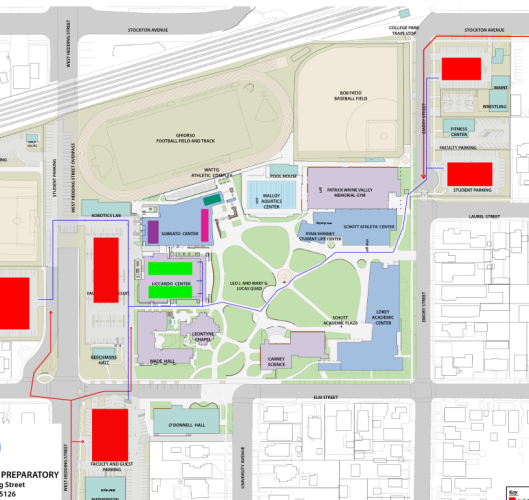
Bay Area Science Festival 2013
On November 2nd, several members from our team, along with our 2013 robot Overkill, participated in the Bay Area Science Festival. Along with other FRC teams, Team 254 was able to demo our robot to excited youth and adults. We were able to demo our shooter and our unique climbing abilities. We explained the basics of the robot and the game to curious youth and the intricacies of the robot to curious adults. Overall, we had a blast and hope to participate again.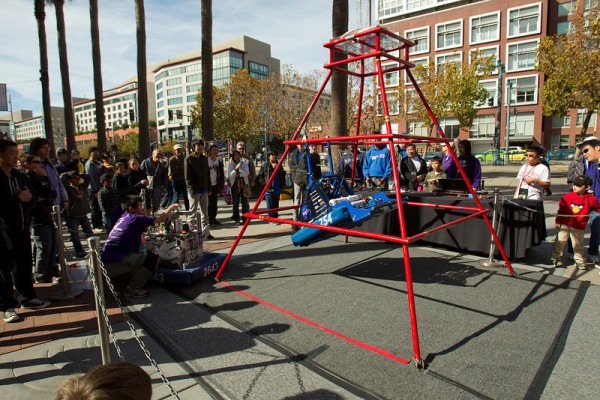
Team 254F and 254A win VEX Tournament
On Saturday, October 19th, all 7 of Team 254’s VEX Teams competed at the Dougherty Valley High School Robotics Tournament in San Ramon. Subteams A through G competed well during qualification matches. One of the most memorable highlights was that in the first match of the tournament when four 254 teams ended up in the same match! Teams F and G beat Teams D and B in match that was both extremely unlikely and unfortunate to watch as it put 2 of our teams behind right from the beginning. Because the tournament was running late, they had to cut number of qualification matches from a scheduled 7 down to only 4. However, most of our teams still did well. Team F went undefeated and was ranked second. Teams D, A, and B finished in 19th, 20th, and 21st place, respectively.
During alliance selection Team 254F picked the Team 21, the Spur Flies and later Team 254A. Team 254G was picked by fourth ranked 8000A and later allied with Team 6088. Team 254D and 254E were picked by Team 1868X, the Space Cookies. Finally, Team 254B was chosen by Team 21C and allied with 9378A.
In the elimination matches, Team G’s alliance defeated Team B in the quarterfinals, and the alliance of Team D and E was eliminated by the number 1 ranked alliance, 9378R, 8000B, and 8000C. In the semifinals, Team F eliminated Team G. Team 254F and 254A went on to the finals to play against the number one ranked alliance. After 2 stressful and intense matches, Team F and Team A managed to capitalize on robot failures of the opposing alliance and secure a victory! By being the champions of the tournament, Teams F and A are now qualified for the California State Championship in March.
Take Flight For Kids
On October 19th, several members from our team had the opportunity to participate in the Take Flight for Kids event hosted by Valley Medical Center Foundation. Along with other FRC teams, Team 254 was able to present the 2013 robot, Overkill to the excited youth and adult that stopped by our booth. We explained the basics of the robot to curious youth and the intricacies of the robot to curious adults. Overall, we had a great time and had a lot of fun.


